If ever there were a time to head outdoors, this is it. Camping is already our national pastime, but this year it may just be our savior — as we seek places where we can actually travel to and achieve some of the serenity we all need. We’ve been taking a good look at camping as of late, everything from pitching a tent, taking the kids, and camping permit-free or in an RV. Here, we bring it all together to let you know our very favorite places to camp, whether by crashing ocean waves or on a lonely mountain pass, in every US state.
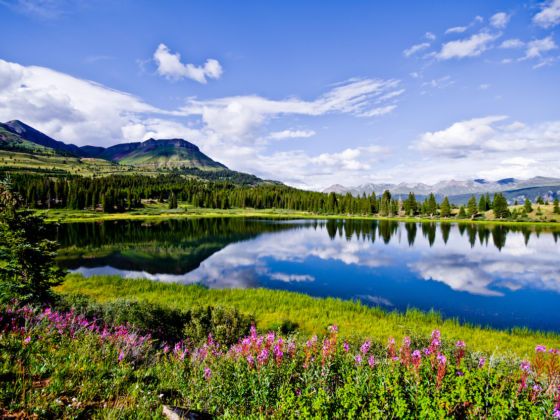
The Best Places to Camp in All 50 States
1. Alabama: Cheaha State Park
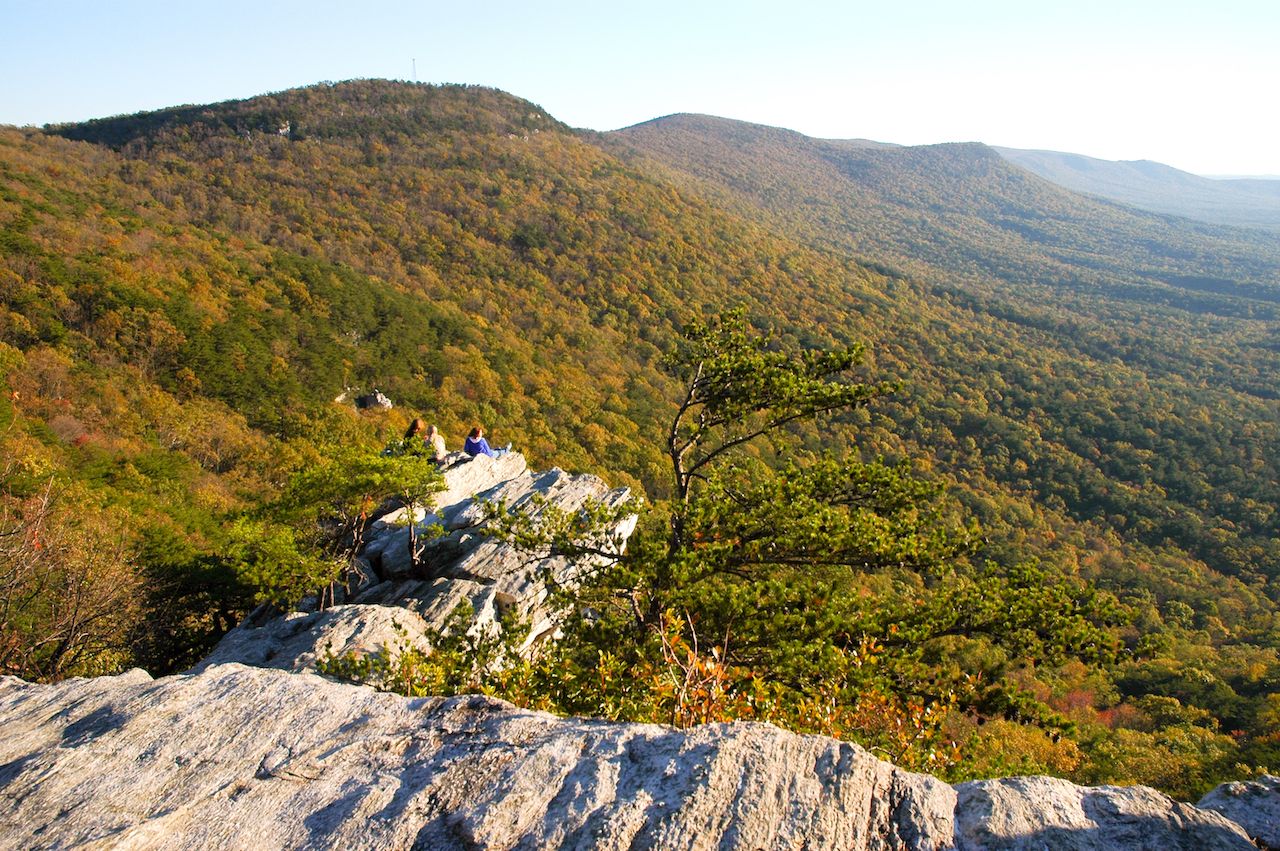
Photo: Jeffrey M. Frank/Shutterstock
Here, pitch a tent beneath Cheaha Peak at 2,413 feet, Alabama’s highest point, and get up early to experience one or more of the great hikes around it. The sunset at Cheaha Point is the best place in the state to look out over the massive green valley that comprises the park and beyond. Plus there’s usually a breeze, so it’s not as unbearably hot as the rest of the state during the heat of the summer.
Cheaha has both primitive and serviced campsites available for advance reservation through Alabama State Parks. The park is just south of Interstate 20 roughly halfway between Birmingham and Atlanta, Georgia, making it easily accessible from the two largest metro areas nearby. It’s also two hours north of Montgomery and 2.5 hours south of Huntsville, an easy drive considering the reward is a complete change of pace.
2. Alaska: Thompson Pass

Photo: Steve Bower/Shutterstock
Alaska’s Chugach Mountains are the stuff of legend in the ski world, and Thompson Pass, outside of Valdez, is the epicenter of their accessibility. The tallest peak in the range, Mount Marcus Baker towers 13,094 feet above the sea that’s just a short distance away. Most mountains in the range are far more manageable, however, and you can easily pop a tent or park your RV at Blueberry Lake State Recreation Area.
The pass is also a great place to backpack into the wilderness, pitching your tent for the night in total seclusion. The highway over Thompson Pass offers numerous trailhead pullouts where you can park and hike in as far as your legs will take you. Just be prepared for inclement weather and a short summer camping season from late June through September.
3. Arizona: Oak Creek Canyon
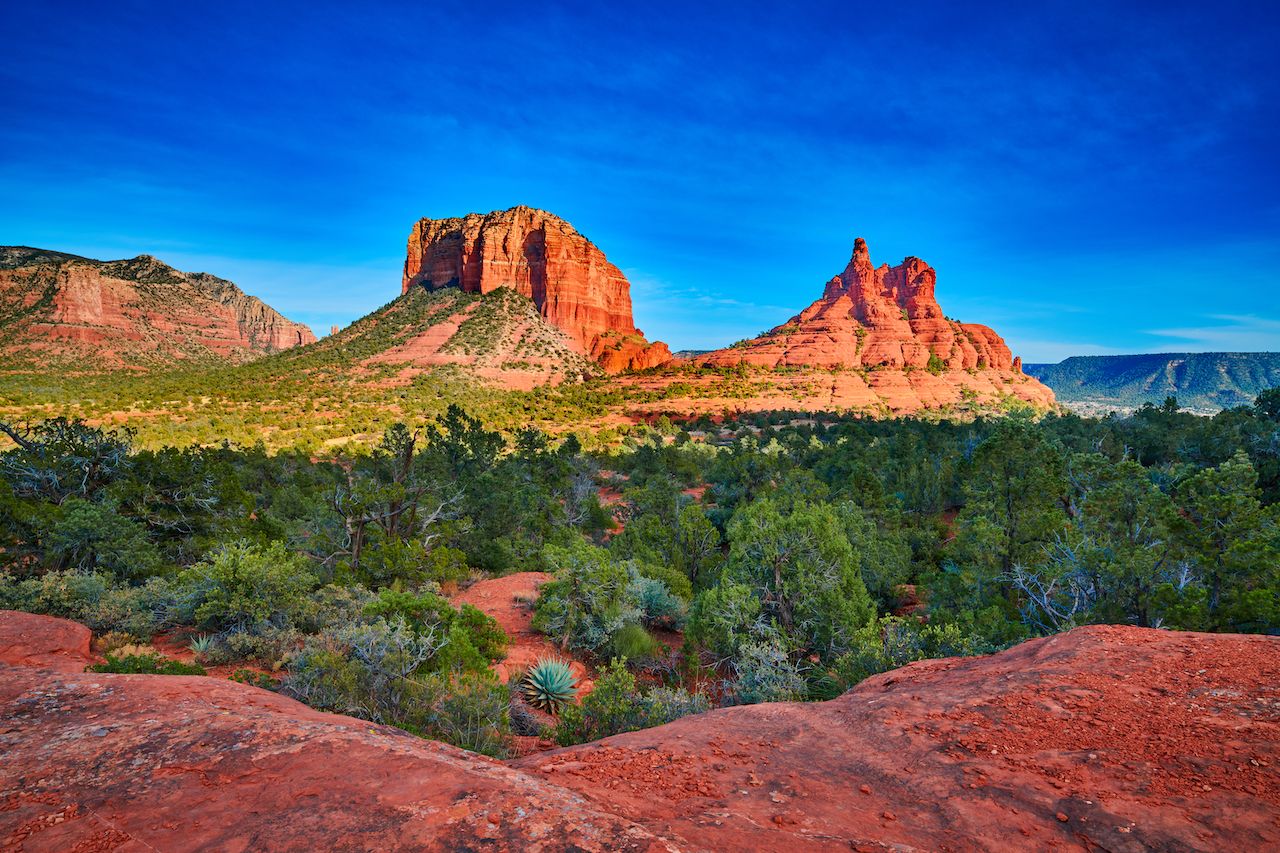
Photo: Patrick Jennings/Shutterstock
Northern Arizona combines the best elements of desert and mountain terrain unlike anywhere else in the United States. In Oak Creek Canyon, close to Sedona, Manzanita Campground has 18 sites set along a bubbling creek with some of the state’s top hiking and biking paths branching out from the area. The famed Bell Rock formation is nearby for ‘gram-worthy photos. Here, you’re high enough that the temperature stays well below 100 degrees and summer evenings are cool and relaxing. Even if it does get hot, dip into one of the onsite swimming holes to cool off.
4. Arkansas: Cove Lake
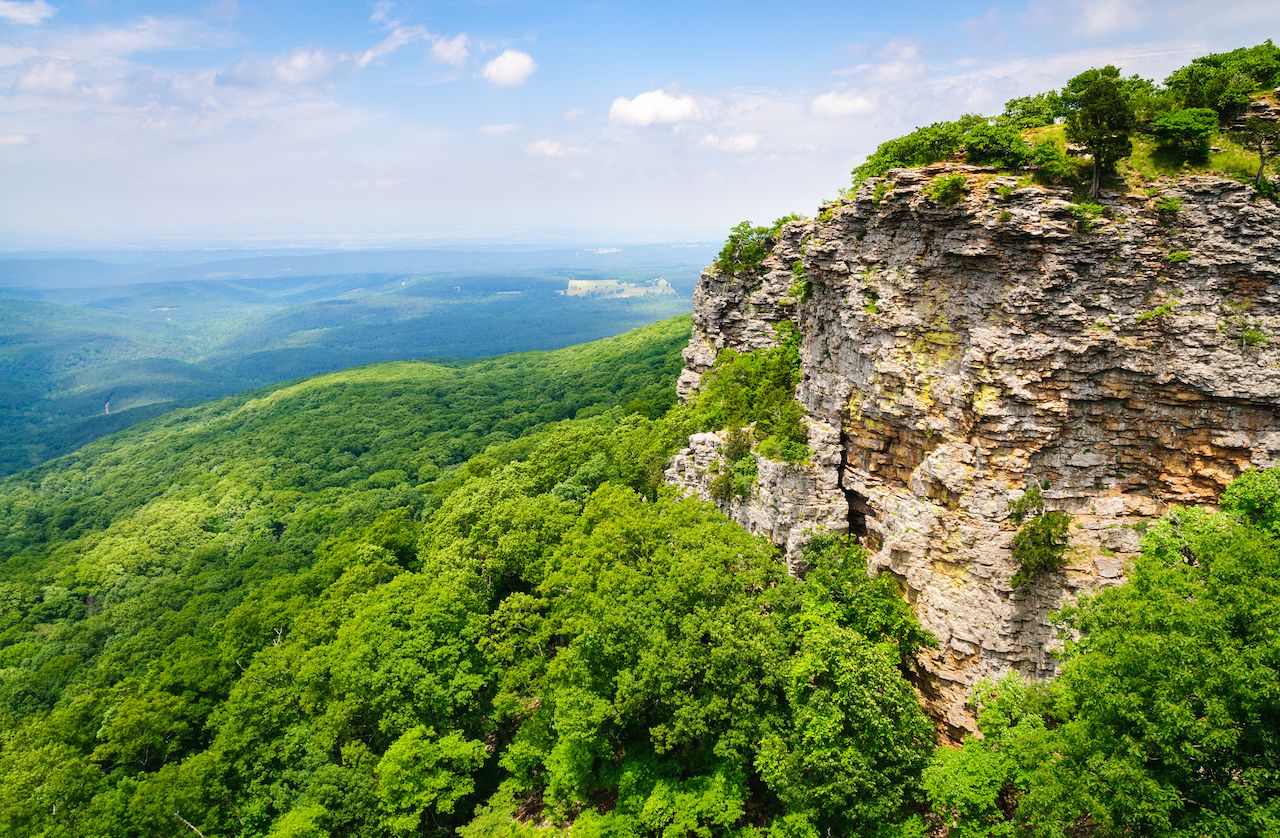
Photo: Zack Frank/Shutterstock
Easy to access and near the state’s highest peak, Mount Magazine, Cove Lake is the perfect spot for outdoor recreation on both water and trail. In-water is also doable, if a dip is in order, though you may find yourself brushed and coddled by catfish or bass as the lake is home to some of the state’s best fishing. By spending the night, you can snag the best spot to cast a line in the morning. Head out on the Cove Lake Trail and tour the 2,753-foot Mount Magazine and surrounding state park, with other popular trails including Dripping Springs Trail and Bear Hollow Trail nearby.
5. California: Big Sur

Photo: Songquan Dang/Shutterstock
California may well be the hardest state in which to choose just one location as the ultimate camping spot — but if you’ve ever camped in Big Sur, then you know it’s the place to go. With its Santa Lucia coastal range and bluffs that tower over the Pacific Ocean, Big Sur combines most of the best things about California’s outdoors: ocean sunsets, mountain trails, and very big trees.
Campsites in places like the Pfeiffer Big Sur Campground or the campgrounds at Andrew Molera State Park would be incredible enough for their cliff-top location and ocean views. But Pfeiffer Big Sur and Julie Pfeiffer Burns state parks, both among the best state parks in the US, also have 80-foot-tall waterfalls and 2,500-year-old redwood trees that soar over 300 feet into the sky. And if the bobcats, deer, and dozens of bird species aren’t enough for you, just look towards the ocean. Big Sur is one of the prime spots in California for whale watching.
6. Colorado: Million Dollar Highway
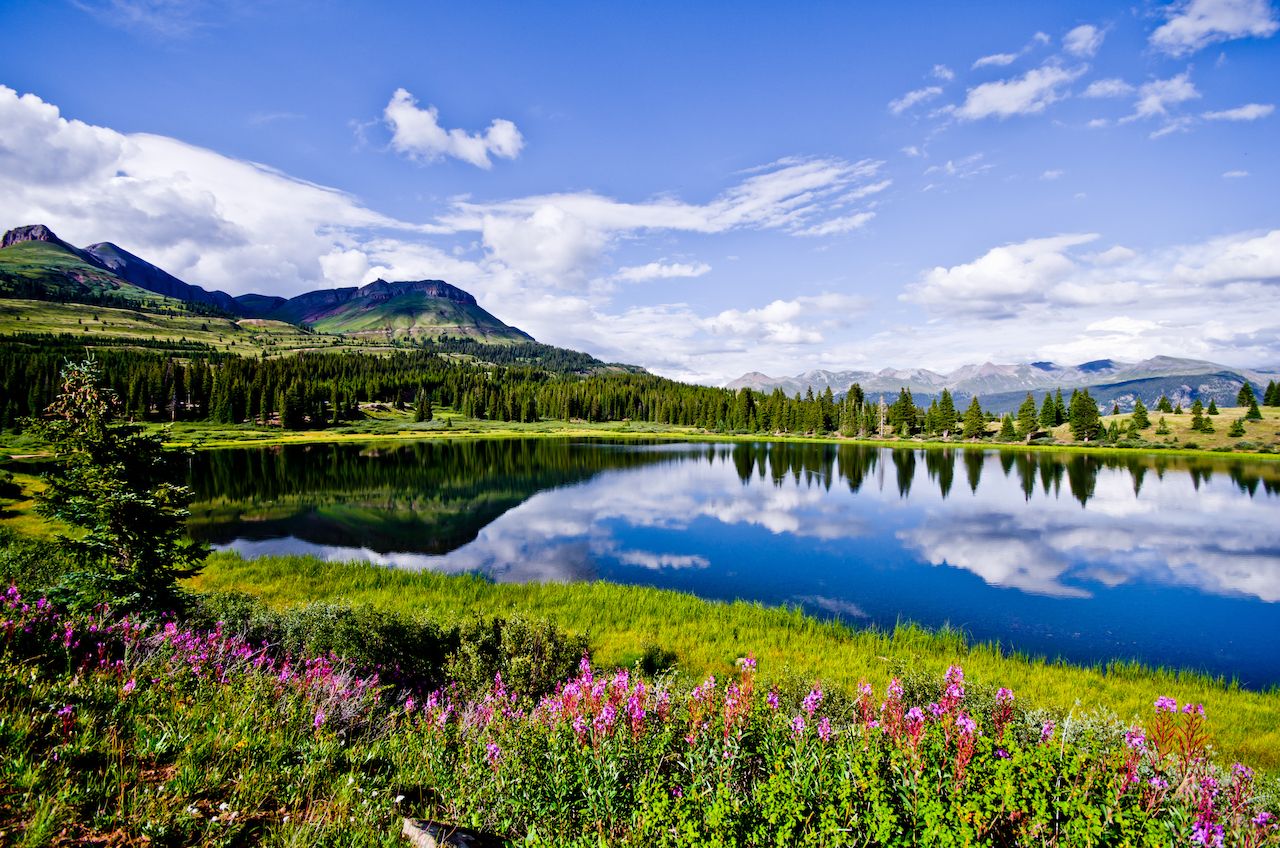
Photo: Robert Bohrer/Shutterstock
Don’t let the name be off-putting. The Million Dollar Highway, a stretch of US Highway 550 between the towns of Durango and Ouray, is one of the most beautiful stretches of road in America. It traverses the San Juan Mountains over Molas, Coal Bank, and Red Mountain passes, each lined with hiking and backpacking opportunities as well as high-alpine lakes and the locally renowned hikes of Engineer Mountain (12,968 feet) and Potato Hill (11,871 feet).
For campground access, pull into Molas Lake Park and Campground. This high-alpine facility is about as close as you can sleep to the mighty peaks of the Needles and Weminuche Wilderness without expending ample effort — simply pull in, reserve, and set up camp. Sites run $20 per night, with RV hookups and amenities available.
7. Connecticut: Macedonia Brook State Park
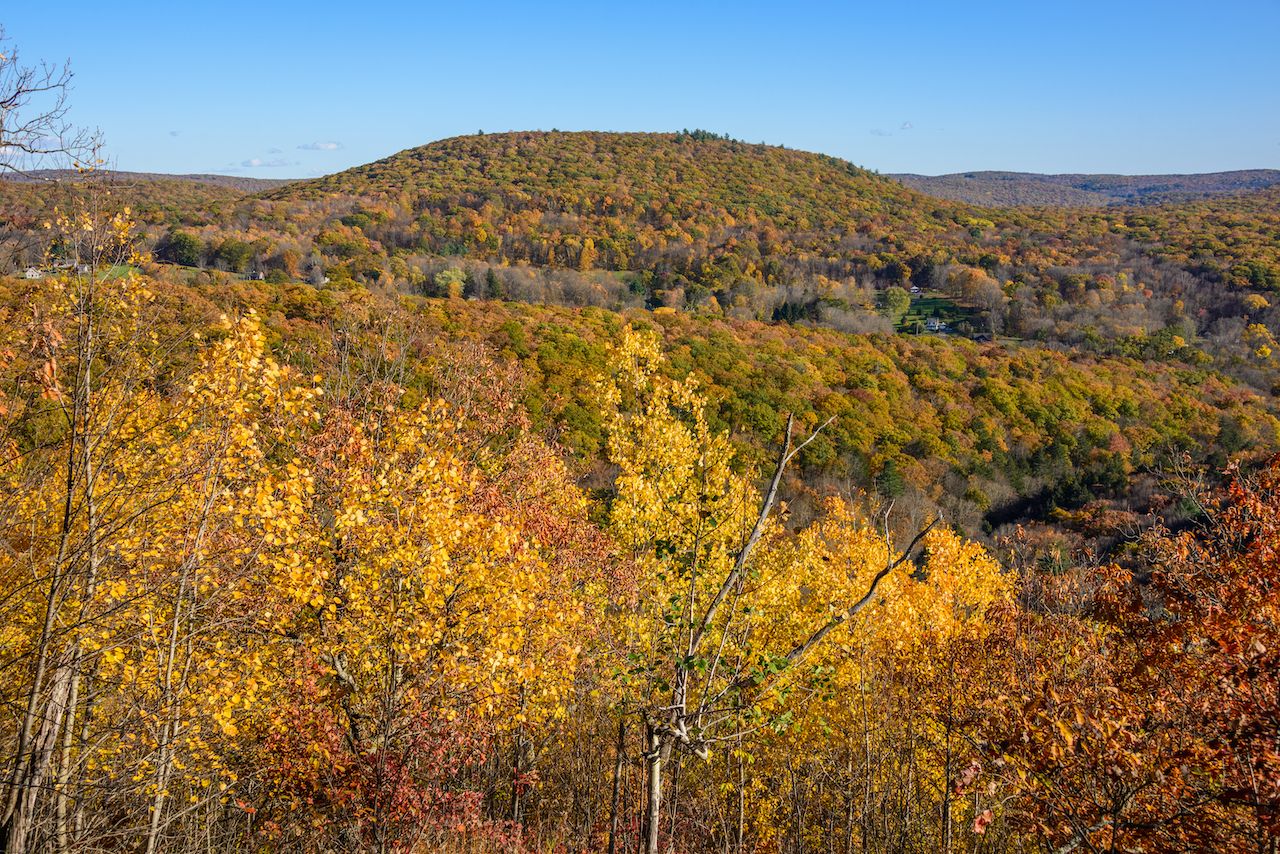
Photo: Tomaz Kunst/Shutterstock
Connecticut is a tough call, as a well-loved way to spend a summer weekend is at Hammonasset State Park on the northern end of Long Island Sound. But that’s the rub: The spot is popular, and with 550 camping spots, it doesn’t quite feel like a serene camping escape.
So in Connecticut’s case, our favorite getaway would be to head well west, towards the wooded peaks at the northern end of the Appalachian Trail and Macedonia Brook State Park. Its 2,300 acres are crisscrossed with trails leading to Pond Mountain and other viewpoints where you can take in the Catskills and Taconics ranges. Just note that by opting for rustic hills over a populated shoreline location, you’re also giving up on some other amenities. Paths here are not well-traveled, so pay attention to the paint marks indicating the way.
The park’s 51 basic campsites are spread out on either side of the picturesque Macedonia Brook itself, and many are well-shaded by birch or pine trees. And if you do want a little bit of civilization, the town of Kent offers up a microbrewery and an outdoorsy town vibe.
8. Delaware: Rehoboth Beach

Photo: David Kay/Shutterstock
In American pop culture, visions of the Atlantic Coast are often shaped by Jersey Shore or the Carolinas. But it’s the in-between of those states and beaches that beckon to the campers looking for a slice of coast, sans-hassle. On Rehoboth Beach, Big Oaks Campground gives families, couples, and individuals a break from the urban scene of the East Coast, without having to sacrifice amenities like water and power. A basic campsite runs $41 per night, but there’s plenty of space for RVs and tow-behind campers as well — all within a quick hike or bike ride from the beach.
9. Florida: Bahia Honda Key
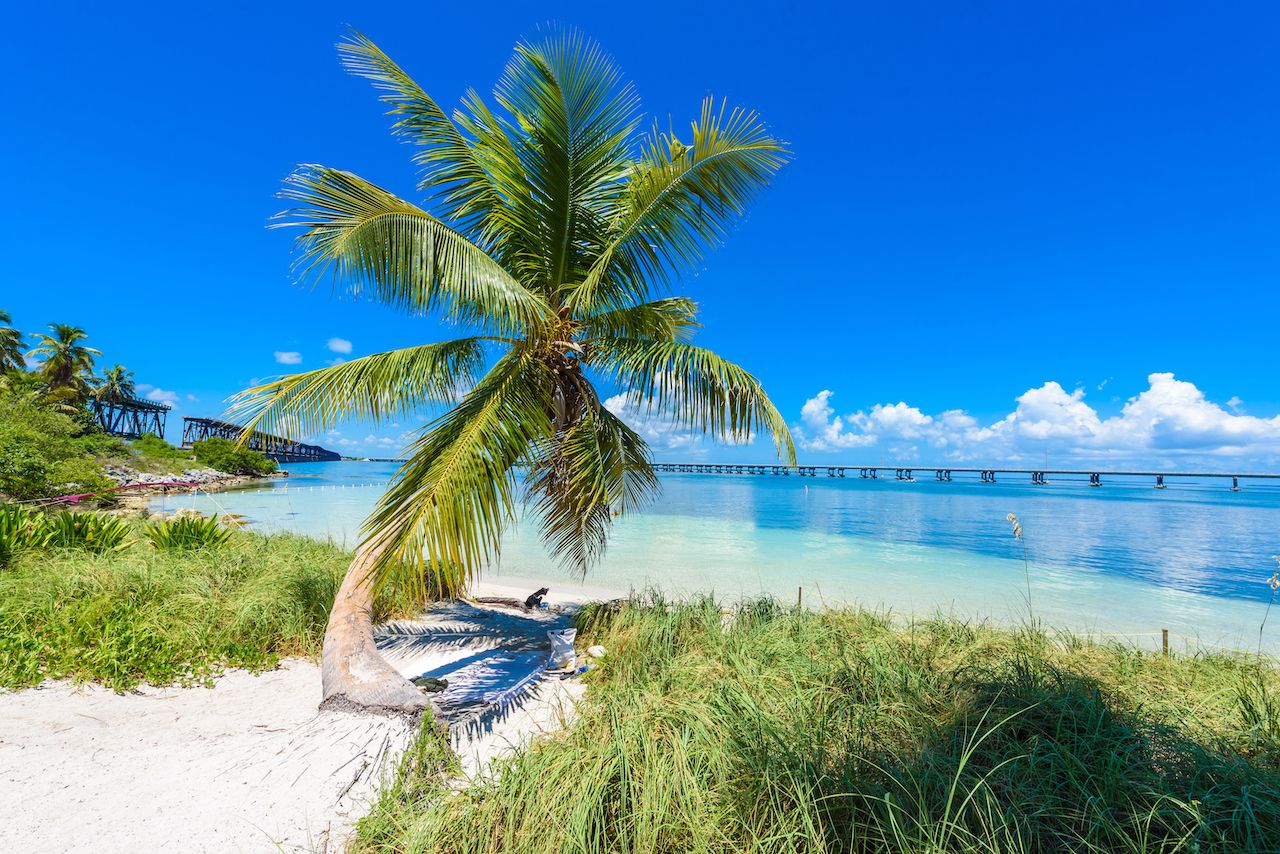
Photo: Simon Dannhauer/Shutterstock
It isn’t everywhere that you can camp while also engaging in activities more commonly found on guided boat tours. Then again, this is the Florida Keys. Bahia Honda Key, to be exact. The entire key is a state park, and camping right along both the Atlantic Ocean and Gulf of Mexico offers walk-in access to snorkeling, fishing, boating, and other on-water activities with both tent camping and rustic lodges available. The Overseas Highway passes right through the middle of the key, should a hunch for a night out in Key West or Key Largo strike.
Reserve a camp spot in advance and don’t feel guilty if you bring a boat load with you — literally. It’s quite common to see campers hauling in boats, jet skis, and other recreational equipment to Bahia Honda Key. This is Florida, after all.
10. Georgia: Tallulah Gorge State Park
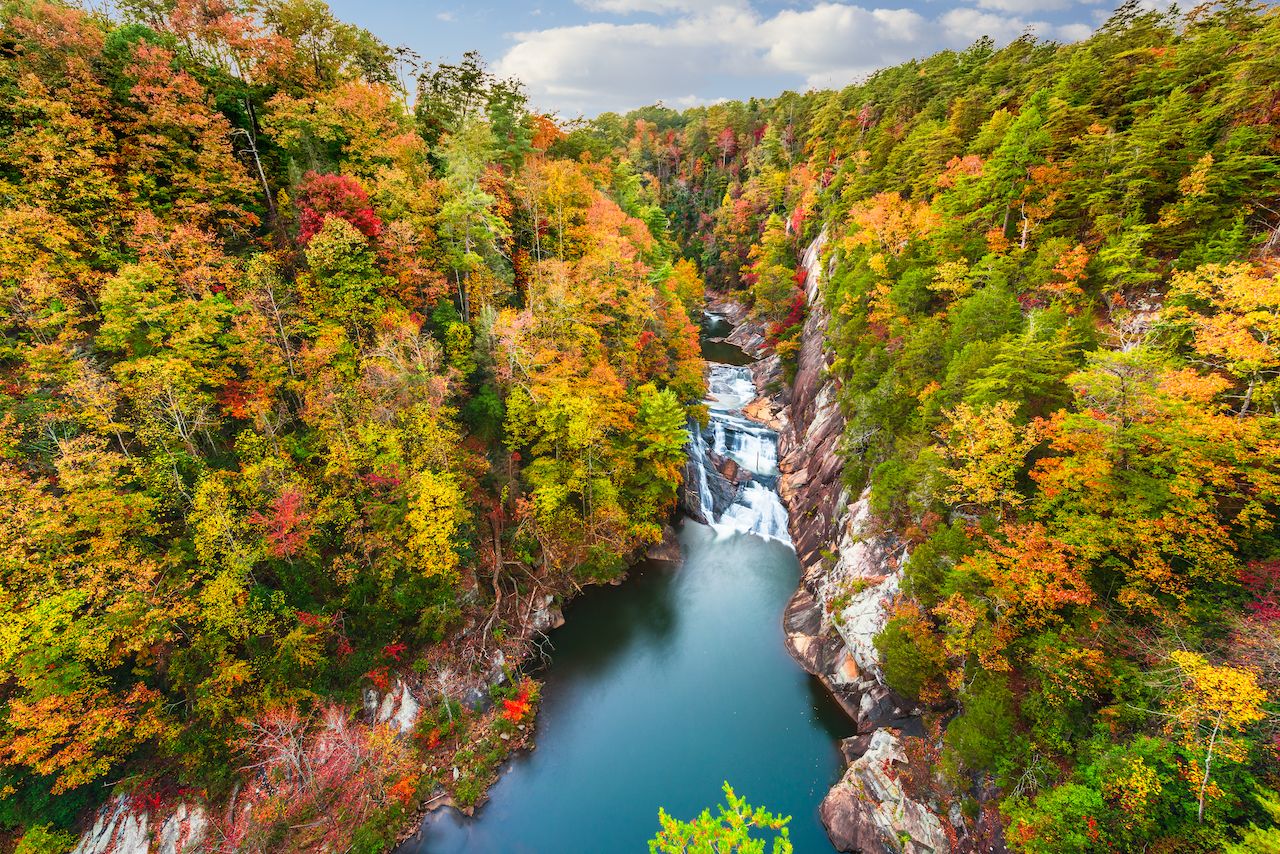
Photo: Sean Pavone/Shutterstock
The beauty of Georgia is vastly underrated in outdoorsy circles. Anyone that doubts this should be directed straight to Tallulah Gorge State Park. Here, a slice of mountain high in the Deep South, you’ll find camping on par with anywhere in Appalachia and a camping-driven culture of backcountry enthusiasts that apply Southern grit to their passion for adventure. Show up late in the morning to hike the rim trails overlooking a 1,000-foot-deep gorge before setting up camp at Pioneer Campground or one of the Adirondack Shelters, for those needing a bit more of a solid roof over your head. The next morning, hike down into the gorge (apply for the permit to do so in advance) or hit the 10-mile mountain bike trail that runs through the park.
Tallulah Gorge attracts some of the best climbers in the South, so stop and watch their technical work and try not to get distracted by the salamanders and orchids that dot trail and tree. The park is an hour and a half northeast of Atlanta and about two hours from Asheville, North Carolina.
11. Hawaii: Haleakala National Park

Photo: Bill Florence/Shutterstock
Most people don’t need much convincing to consider a vacation in Hawaii. The tough part is always deciding where. And while Kauai is our favorite island for sheer adventure, we’re going to call this one for Haleakala National Park, because watching the sunrise from the top of a 10,000-foot-high extinct volcano — while you’re on an island in the middle of the Pacific Ocean — makes that 4 AM wake-up worth every minute of lost sleep. (Just be sure to reserve to watch the sunrise, as viewing is limited.) And when you’re staying at a campground right next to the park, you’ll get a few more minutes of that precious sleep.
Not only that, but the Kipahulu campground is very close to the 1.8-mile-long Pipiwai Trail, which traverses lush green trees and a bamboo forest before reaching the soaring, 185-feet Waimoku Falls. Along the way, it passes by the Pools of Oheo, or the “Seven Sacred Pools.” Each of these pools cascades one into the other, and eventually down into the ocean. Here you can cliff-jump and swim, or just take in the natural wonder. The hike’s beauty also makes it very popular; by staying right nearby, you can explore it early in the day before anyone else.
12. Idaho: Sawtooth National Recreation Area

Photo: CSNafzger/Shutterstock
The Sawtooth National Recreation Area is one of the most beautiful regions of one of the country’s most rugged states. Among Sawtooth’s 10,000-foot peaks, old-growth forests, and hundreds of alpine lakes, the options for outdoor recreation are dizzying — with everything from hiking and rock climbing to fishing and mountain biking. Given that the recreation area covers 756,000 acres, it has literally dozens of campgrounds to choose from. We recommend a campsite by one of the recreation area’s 300 lakes, among them Stanley Lake, which is a popular place for fishing and boating in the shadow of dramatic mountain peaks.
Another impossibly scenic lake is 4.5-mile-long Redfish Lake, which has three national recreation area campgrounds to choose from — Glacier View, Outlet, and Point. With its stunning views and a quiet beach, Point is our favorite. But you can’t go wrong with any campground in the Sawtooth area.
13. Illinois: Castle Rock State Park
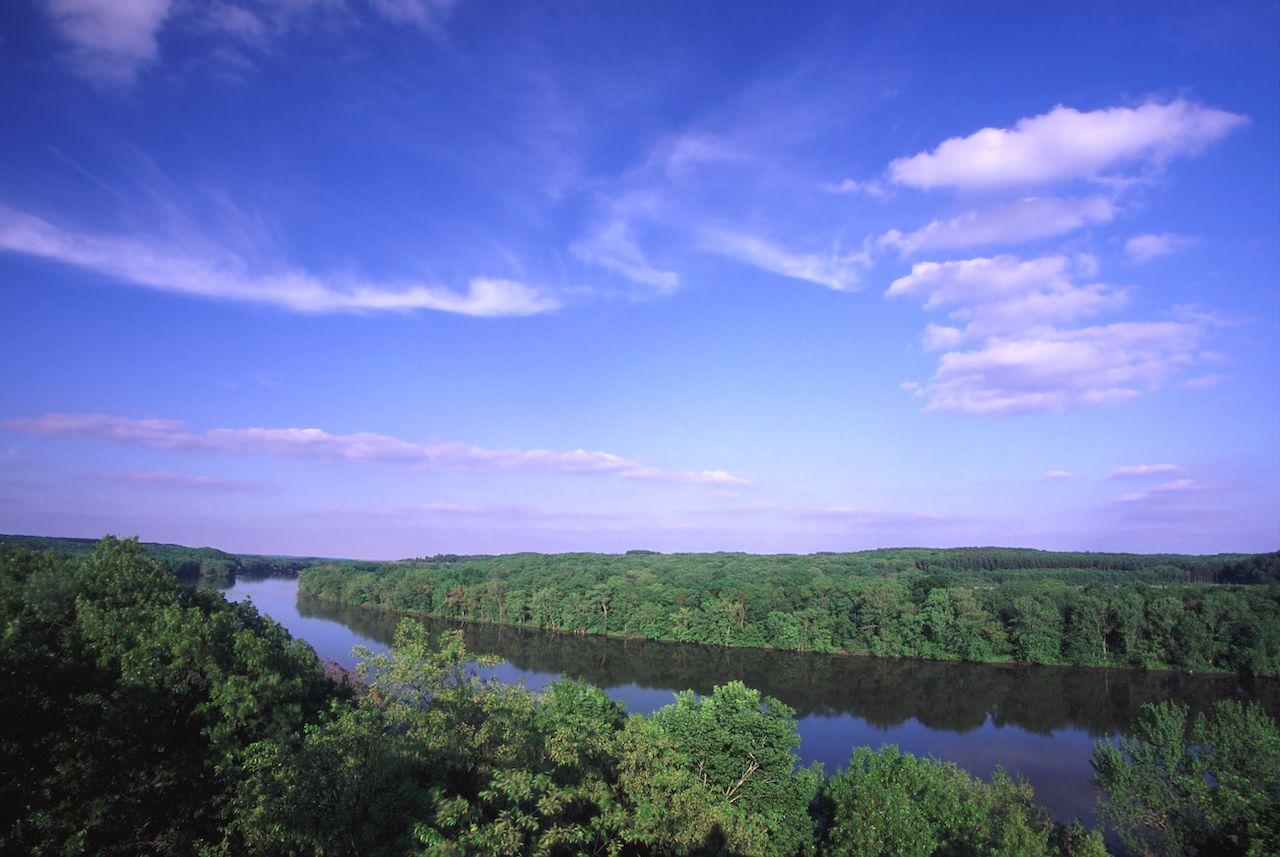
Photo: Jason Patrick Ross/Shutterstock
Many of the country’s best campsites are intentionally difficult to get to. Few are more deserving of the effort it takes to get there than the camping area at Illinois’ Castle Rock State Park, accessible only by boat or canoe. Once there, you’ll be among the select hardy few to experience the fishing from offshore in the Rock River. The camping is first-come, first-set up, and be warned that there isn’t much in the way of established sites — bring a tent and set up at least 200 feet from the water. Views of the Castle Rock and surrounding rock formations are among the most photogenic in the state, and from the campsite, you’re rewarded with a near-guarantee that there won’t be anyone else in your shot.
This is the type of camping experience where new friends are easily made around the campfire, as the scene is mellow and anyone who makes the journey is likely to have tips on fishing and hiking spots for the morning — so bring a beer to share.
14. Indiana: Indiana Dunes National Park
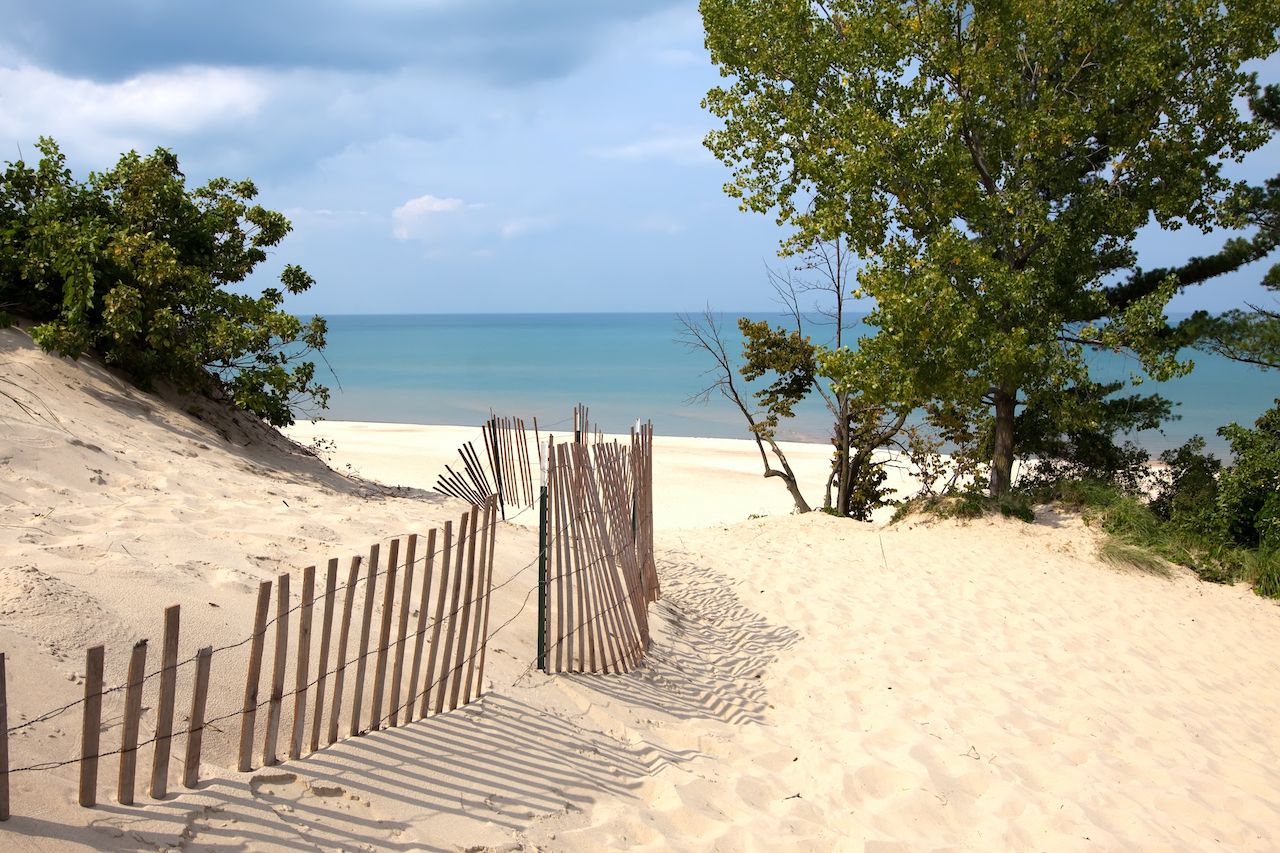
Photo: Delmas Lehman/Shutterstock
When an area gets promoted to “National Park” status during the Trump administration, you know it’s something special. Indiana Dunes National Park is one of the country’s newest national parks, and the Dunewood Campground is not only a gorgeous place to sleep but is also the best spot for easy access to the park when you wake up in the morning. Campsites are open April 1 through November 1, with the majority of the 67 campsites set up to host RVs and campers. It’s $25 per night to camp, but you’re effectively prepaying to get onto the legendary West Beach trails along Lake Michigan, located inside the park, before those coming from further away.
Should you feel inspired at the campsite, wander the 1.5 miles to Lakeview Beach and lounge in the sun. Also available are the massive beachside sand dunes from which the park draws its name, many of which you can climb. But the coolest thing about Dunewood Campground is that you can get here by train. The Beverly Shores South Shore Railroad drops off just a quarter-mile from the campsites.
15. Iowa: Pikes Peak State Park

Photo: Wildnerdpix/Shutterstock
Iowa doesn’t get the hiking and camping cred that western states do, but Pikes Peak State Park proves that the state should at least be part of the conversation. Spend the day trekking the park’s dozen miles of trails surrounded by rising bluffs and towering sandstone. One of those bluffs leads to an overlook of the meeting point of the Mississippi River and the Wisconsin River. After your exploration, relax and recount the day at one of 77 camping spots, 60 with electric hookups. The nightly rate is $16 per spot, with easy access to a nearby convenience store for supplies and snacks.
Families thrive here longside outdoors enthusiasts, and the camp scene has a convivial atmosphere that lends itself to mellow hangs and refreshment rather than all-night parties. If you wake up early, head out to the Point Ann Trail and let the morning wash over you as you gaze out over the nearby town of McGregor.
16. Kansas: Lake Scott State Park

Photo: The Bohemian Lens/Shutterstock
Rock faces, Native American ruins, and plenty of hiking — Lake Scott State Park is as close to the mountain west as Kansas gets. The park is lined with Native American ruins highlighted by the El Cuartelejo pueblo. Cruising into the campsite along the Western Vistas Historic Byway, stop by the historic Steele home, preserved to showcase the lifestyle of early settlers on the plains.
General camping is available, as are two cabins — the Taos and the Navajo — for those preferring a bit more of a “glamping” experience. For the true experience, pitch a tent on one of the 13 permitted camping areas inside park boundaries including the popular Timber Canyon, Flatland, and Spillway camps, each with more than a dozen sites.
17. Kentucky: Cave Run Lake
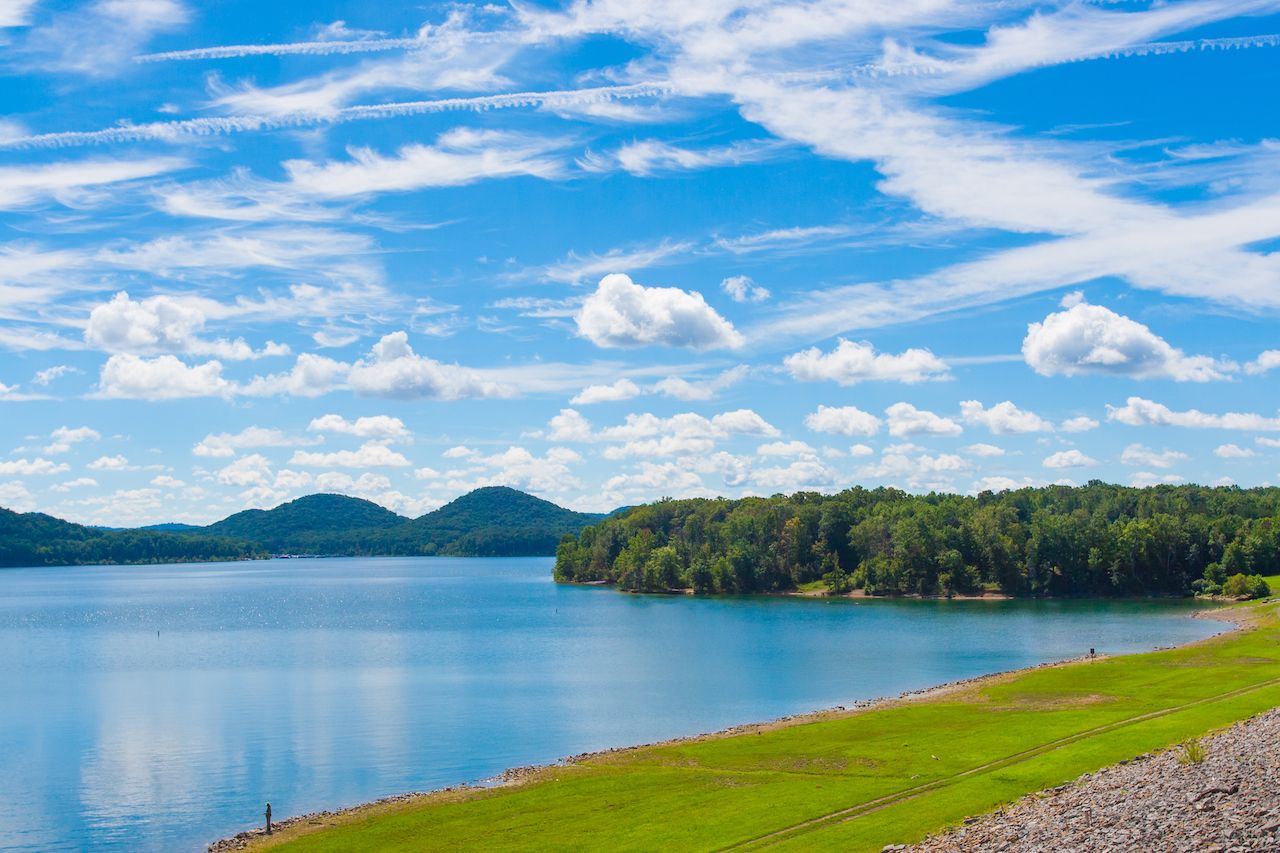
Photo: Irina Mos/Shutterstock
Nowhere does surprises like The Bluegrass State, and in Kentucky Zilpo Campground on Cave Run Lake, the state’s natural diversity is a stunner. There’s a beach, on-water activities, and hiking that even offers notable elevation gain. The park, located inside Daniel Boone National Forest, has both primitive campsites and cabins available for rent, and you can often secure a location right on the beach by arriving early or by making reservations.
The massive 355-acre campground is located adjacent to the lake, with direct access to boating and hiking on nearby trails. Onsite restrooms are available, as is drinking water. For a local’s hack, climb up the park’s firetower to watch the sunset or, if you’re up early, sunrise — it’s mindblowing how far one can see across the park and beyond with just a little bit of effort.
18. Louisiana: Kisatchie Ranger District Wilderness Area
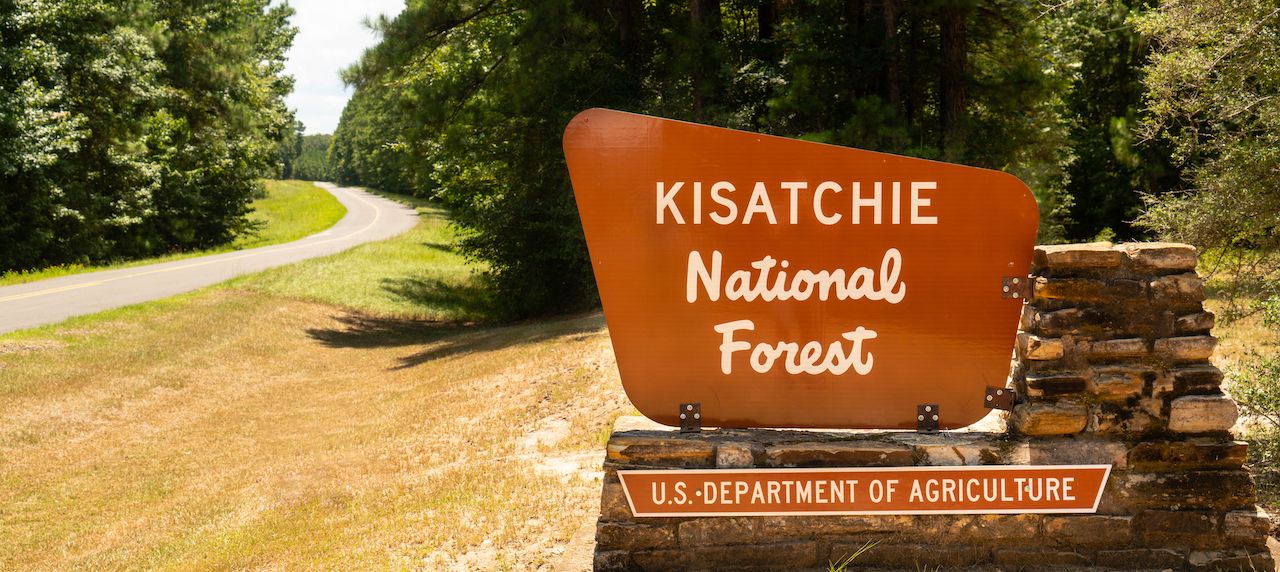
Photo: Real Window Creative/Shutterstock
Louisiana has epic trekking — yes, you read that right — and Kisatchie Ranger District Wilderness Area is where it’s at. This protected area is one of the few places in Louisiana to find elevation, and you’ll have more than enough space to yourself once you get more than a half-mile out on the trail system. Hike as far as you can on the area’s 12 miles of maintained trail, set up camp, and the next morning, either continue on or head back to the trailhead. You’ll also find designated tent campsites that don’t require a hike-to set up.
RVs and campers will find designated areas, the perfect basecamp if you plan to canoe the Kisatchie Bayou or take a bike ride on the area’s 17 additional miles of multi-use trails past some of the most unique terrain in the state. You weren’t expecting bluffs and summits in Louisiana, were you?
19. Maine: Acadia National Park

Photo: Eric Urquhart/Shutterstock
Acadia National Park’s distinction as the only national park in New England does mean that it gets crowded in the summer months — but it’s got national park status for a reason. With glacier-carved mountains, three lakes, and 120 miles of hiking trails set on the shores of the Atlantic, the park is a draw all year. In summer, the Blackwoods Campground is walking distance to Sand Beach, the best place in Acadia to cool off with a dip in the sea. That also makes Blackwoods a very popular summer camping spot; if you weren’t able to reserve within the national park, you can try your luck at the private Mount Desert campground.
In September, the crowds thin out but the days are still warm enough, and places like Acadia’s Blackwoods Campground stay open until about mid-October. In fact, if you reserve in October, you’ll be able to observe the parks’ maple, oak, beech, birch and elm trees burst into vibrant hues of crimson, amber, and gold. Just be sure to bring a warm sleeping bag.
20. Maryland: Assateague Island
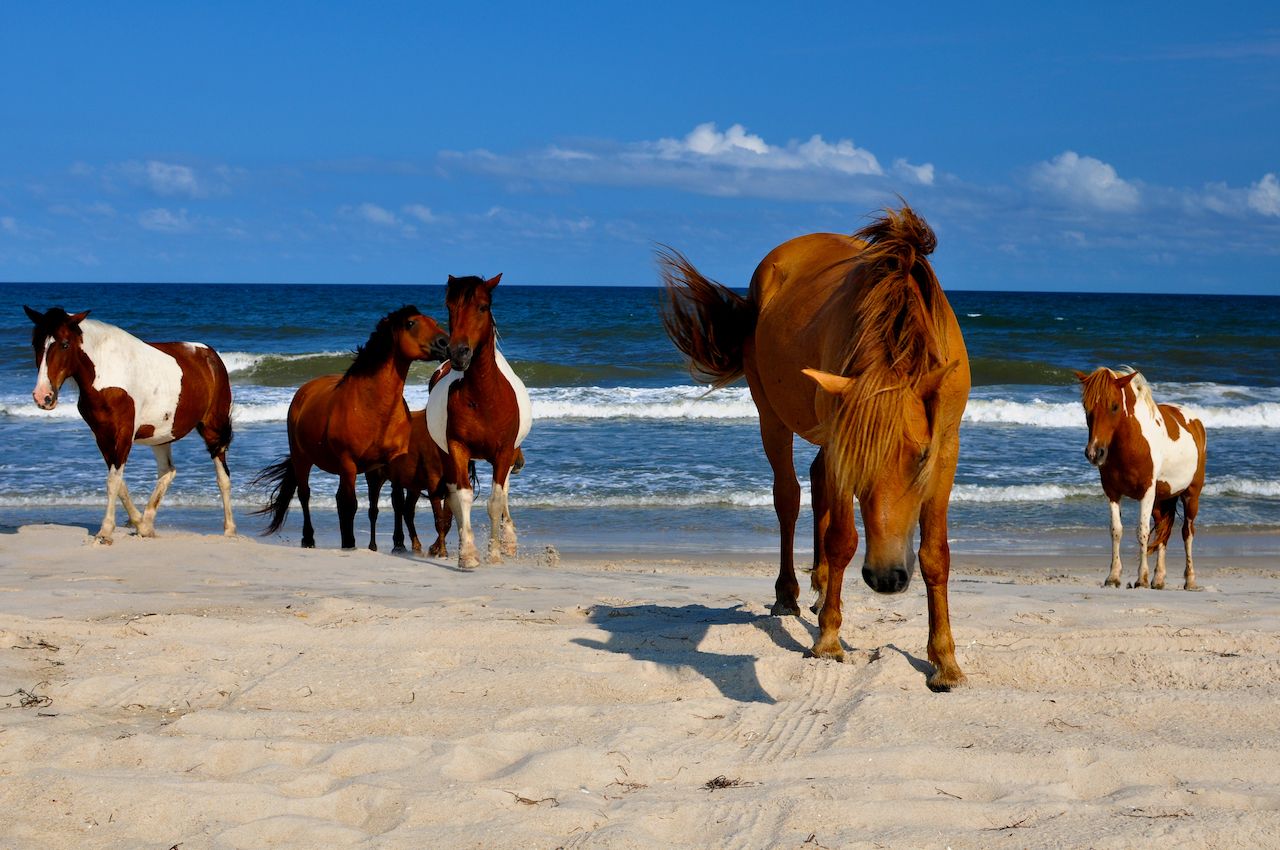
Photo: TonyDE/Shutterstock
Assateague Island National Seashore is about as magical a place as you could find to pitch a tent along the Eastern Seaboard. On this barrier island off the coast of Maryland, wild horses roam pale sand dunes, while trails wend through forests of loblolly pine, red maple, and persimmon. In addition to the wild horses, deer and red fox call Assateague home.
Campgrounds put you within steps of the water’s edge, on the ocean or bay side, so you can sleep with the smell of the salty sea air. There are also shady campgrounds in the backcountry as well. When you wake up from your restful slumber aided by the white noise of gently lapping waves, horse rides on the beach, biking, or kayaking are some of the daytime options.
21. Massachusetts: Cape Cod National Seashore
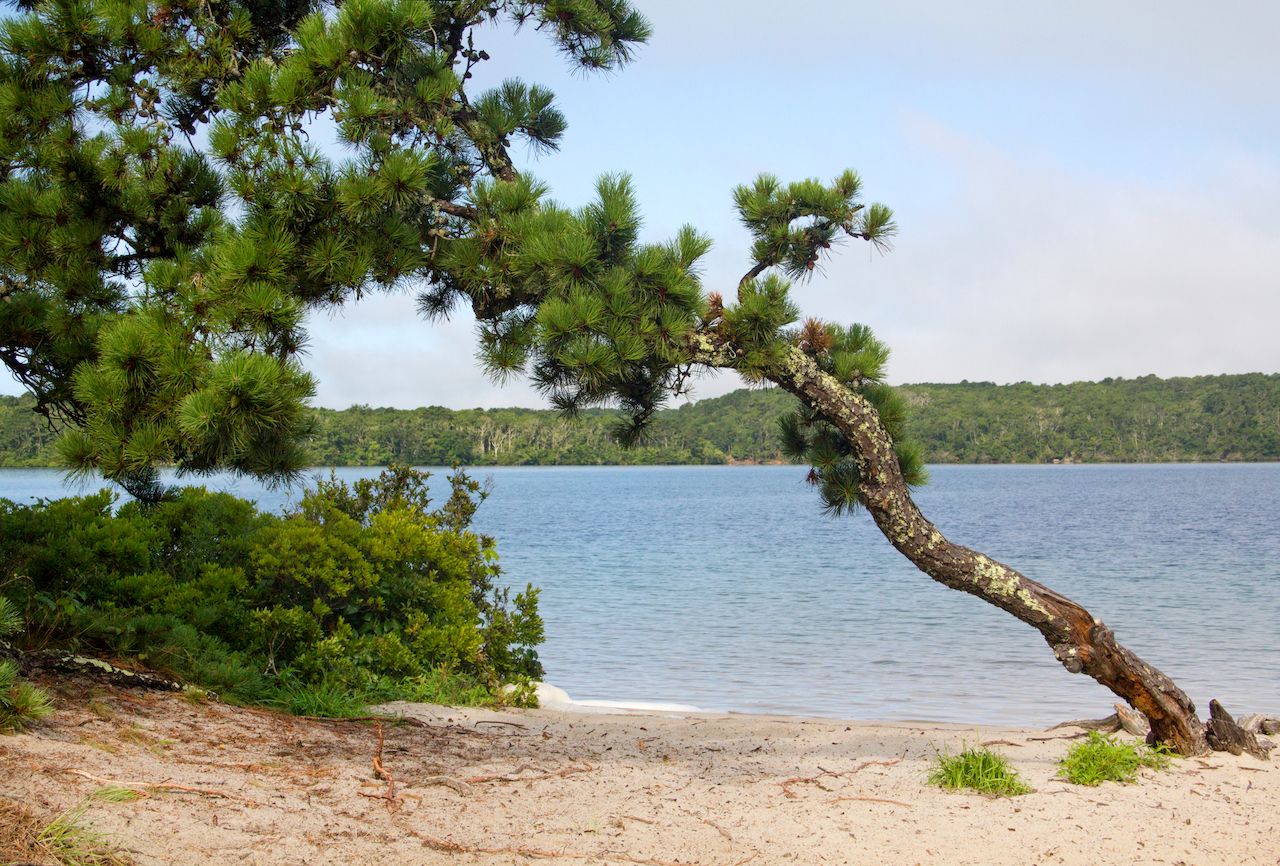
Photo: Jeff Holcombe/Shutterstock
Few things suggest summer in Massachusetts like a weekend in Cape Cod, the hook-shaped outcropping famed for photogenic lighthouses, soft-sand beaches, and classic beach towns. Within the popular cape, the Cape Cod National Seashore feels just a bit more remote, with miles and miles of soft sand beaches that look out onto the open Atlantic Ocean — often hidden behind tall grassy dunes.
The perfect place to camp close to the national seashore is at Nickerson State Park, on the more protected, bay-side of the Cape. If you bring your bike, you can ride to the 22-mile Cape Cod Trail. The park has over 400 campsites, including yurt tents with bunk beds as well. Just note that campsites are more expensive for out-of-state residents. Although they’re only $22/night for locals, they’re $70/night for non-residents, plus an additional $5/per person. It does add up, but when you see those water views, it will have been worth it.
22. Michigan: Isle Royale National Park
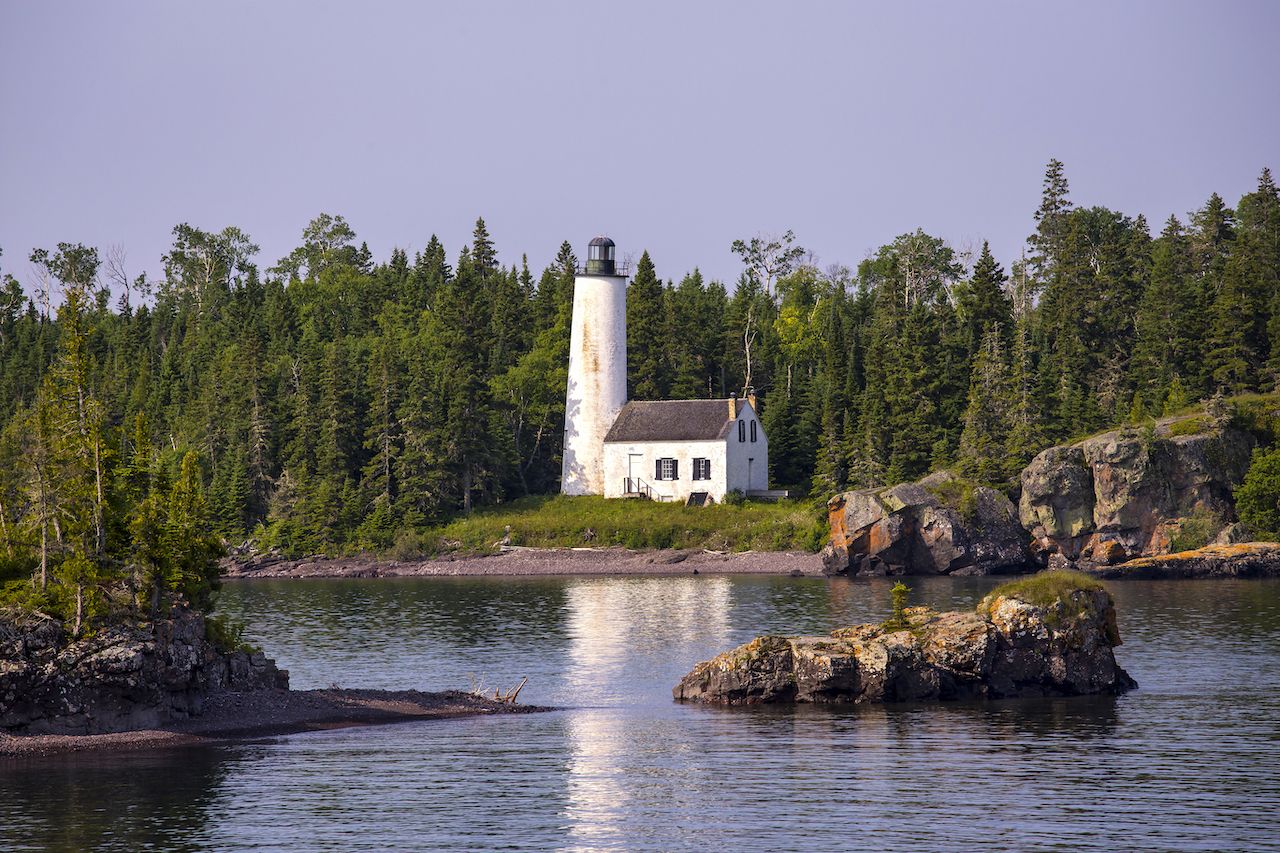
Photo: Steven Schremp/Shutterstock
Isle Royale National Park has the distinction of being one of the least-visited national parks in the country, receiving fewer than 26,000 visitors in all of 2018. The three-hour boat ride, departing from a town four hours north of Green Bay, explains some of the park’s isolation. But the effort to get there is well worth it, as this glacier-carved area boasts 170 miles of hiking trails, many of them through ancient boreal forests. You can also fish on Lake Superior, with a 24-hour license purchased at a concession stand, or canoe and kayak in the area’s many bays and islands.
While the national park includes 450 smaller islands, the 36 campgrounds are all on the main island of Isle Royale. We recommend the campgrounds that are only accessible by canoe and kayak, as you’ll wake up to the sound of the forest — and not any boats, since motorized boats aren’t permitted in that area. You will need a backcountry permit for all overnight stays.
23. Minnesota: Boundary Waters Canoe Area Wilderness
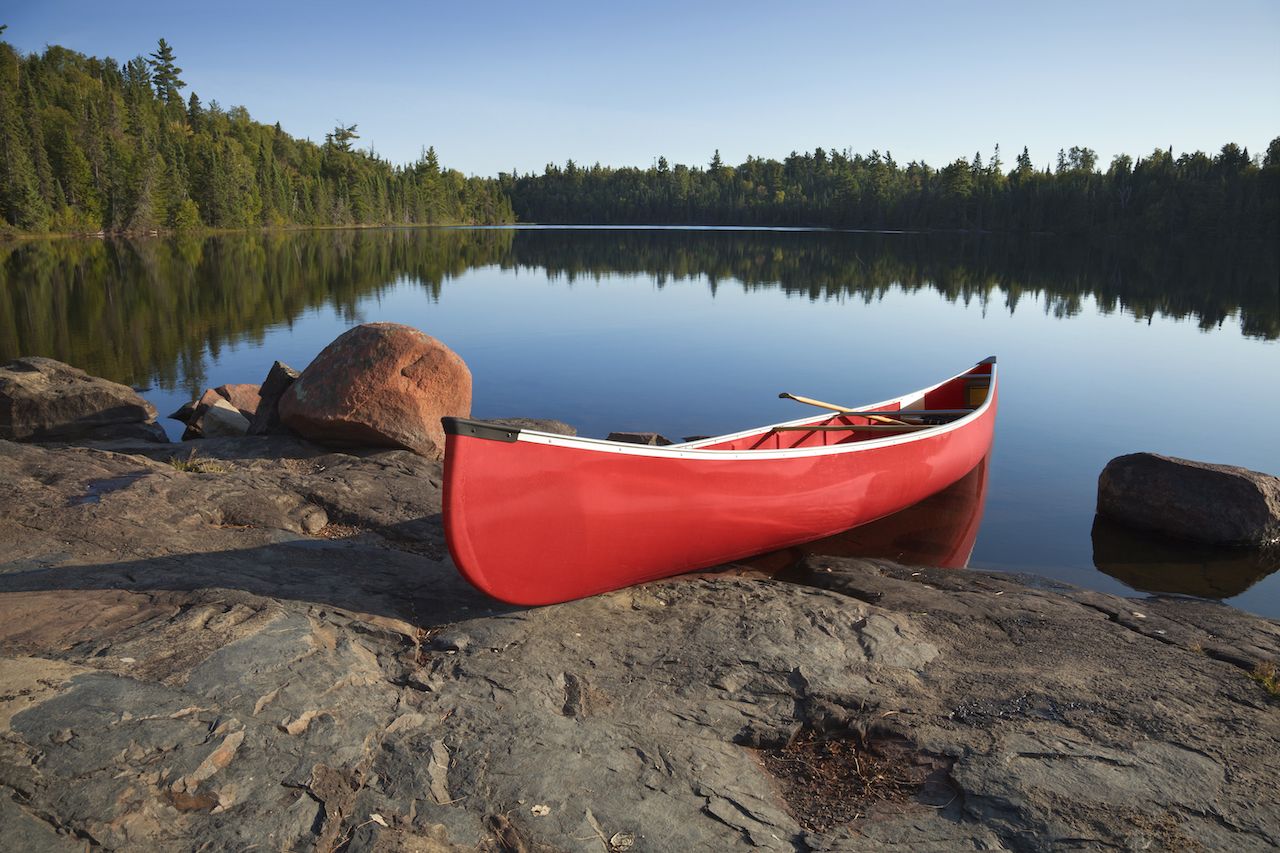
Photo: Dan Thornberg/Shutterstock
The Boundary Waters Canoe Area Wilderness spans a remarkable one million acres of the Superior National Forest and is one of the most untouched regions of the US. Butting up against the border with Canada and including Quetico and La Verendrye Provincial Parks, this massive area has more than 1,000 lakes offering 12,000 miles of canoe routes. Fortunately, there are also multiple places where you can rent a canoe for yourself, since many of the 2000 campsites are best accessed by canoe. Where you camp depends a lot on what canoe entry point you want to take, and there are 70 entry points into the area.
Before canoeing in, you should pick up a self-issued permit from the kiosks at the BWCAW entrances and enter through the entry point for which you have a permit. Note also there are quotas for the summer seasons, so reservations are recommended. All that said, if you are not experienced at canoeing, rowing from one primitive campground to another may not be your thing. That’s fine, too, as there are drive-up campgrounds near the BWCAW, like the Trail’s End Campground on the Seagull River, within the Superior National Forest.
24. Mississippi: Tishomingo State Park

Photo: traveler jordan/Shutterstock
Tishomingo State Park is the place to head for the Appalachian experience in Mississippi. Most campsites and cabins — reservable in advance — are spread around Haynes Lake and nearby Bear Creek, which means you can fish first thing in the morning and last thing before supper. Tucked in the Appalachian foothills, you’ll find hiking and birding available on trails that wind past massive boulders. You cruise into the park on the historic Natchez Trace Parkway, originally cut into the landscape in the 1800s, and once inside will pass by Native American ruins and excavation sites on foot or in your vehicle.
A must-do in the park is Bear Creek Canyon on the famous Bear Creek Outcropping Trail, which runs 3.5 miles round-trip along the creek from the CCC Camp Trail and campsites. Look up to sandstone towers, look down at the stunning canyon crevice and creek below. Either way, be prepared for a sore neck and a full camera.
25. Missouri: Lake Wappapello State Park
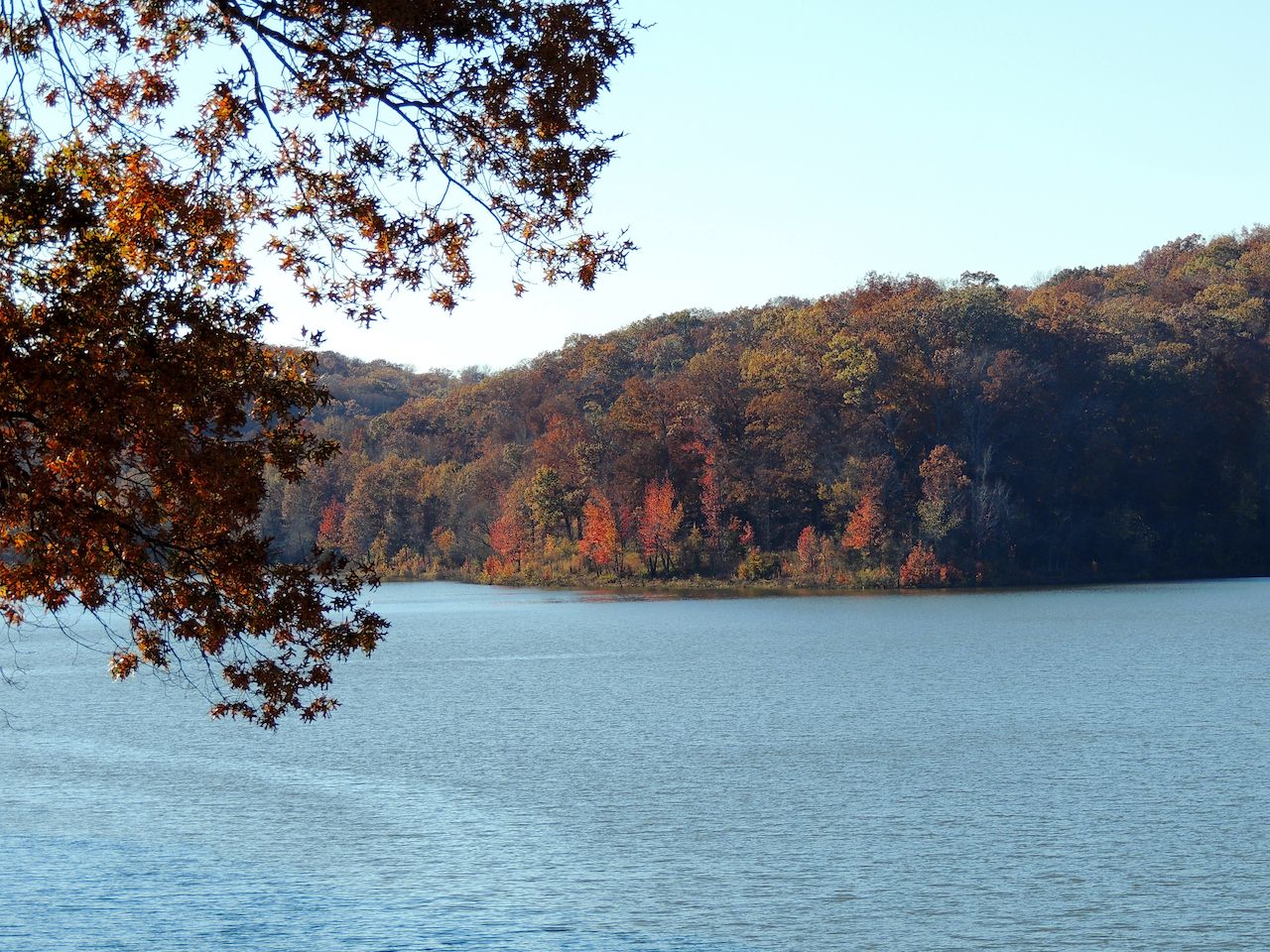
Photo: Al Spencer/Shutterstock
Backpack into Lake Wappapello State Park and experience the best of the Midwestern wilderness. Or stick to the established campgrounds, of which there are two, from April through October — or year-round at limited spots within the Ridge Campground. Heavily forested, the park is the gateway to the west side of Lake Wappapello, among the premiere boating lakes in a state that knows a thing or two about boating. Motorized and non-motorized craft are permitted, including jet skis.
To get out on the water, many boat rental sites are available including Breakin Waves Rentals inside the park itself. If you prefer to stick to dry land, do some or all of the 8.6-mile Lake Wappapello Trail or the easier 2.6-mile Alison Cemetery Trail.
26. Montana: Gallatin River Valley
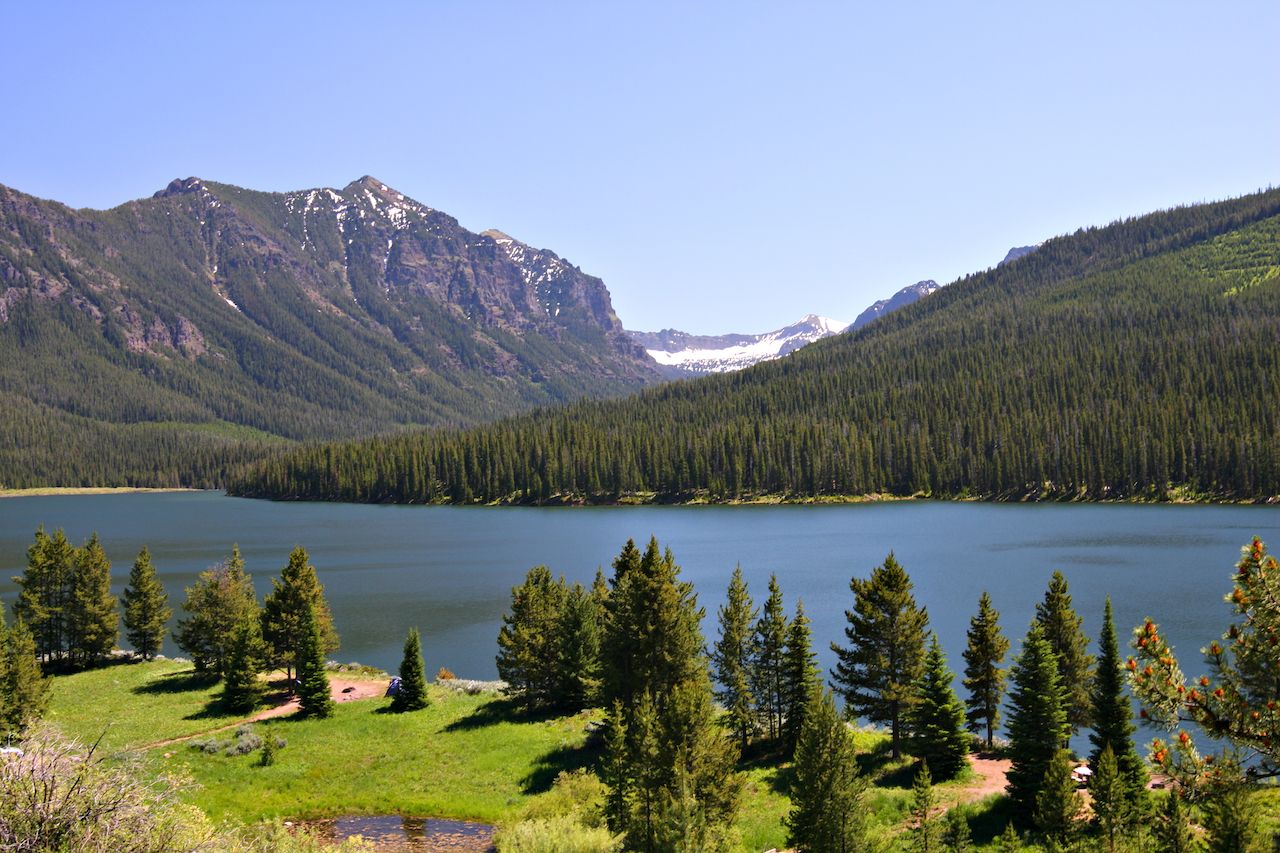
Photo: Flashon Studio/Shutterstock
The Treasure State offers no shortage of camping — the state is known for its outdoors. But the jackpot lies along Highway 191 in the Gallatin River Valley: Here, tucked into the hillsides south of Bozeman but before you hit West Yellowstone, lies the wide open spaces of Big Sky Country. You can fish, hike to Lava Lake or any number of surrounding peaks, or just lay out and stare up at the clouds. Here, no one can (or would) blame you.
The best part is that there are so many options of places to do these things. Montana is the one place that gives Texas a run for it’s “everything’s bigger here” money. Pull up into Gallatin Custer National Forest and pitch a tent, or go more formal at Spire Rock, Greek Creek, or Swan Creek Campgrounds. Fees vary by campground, but dispersed camping is always free.
27. Nebraska: Victoria Springs State Recreation Area
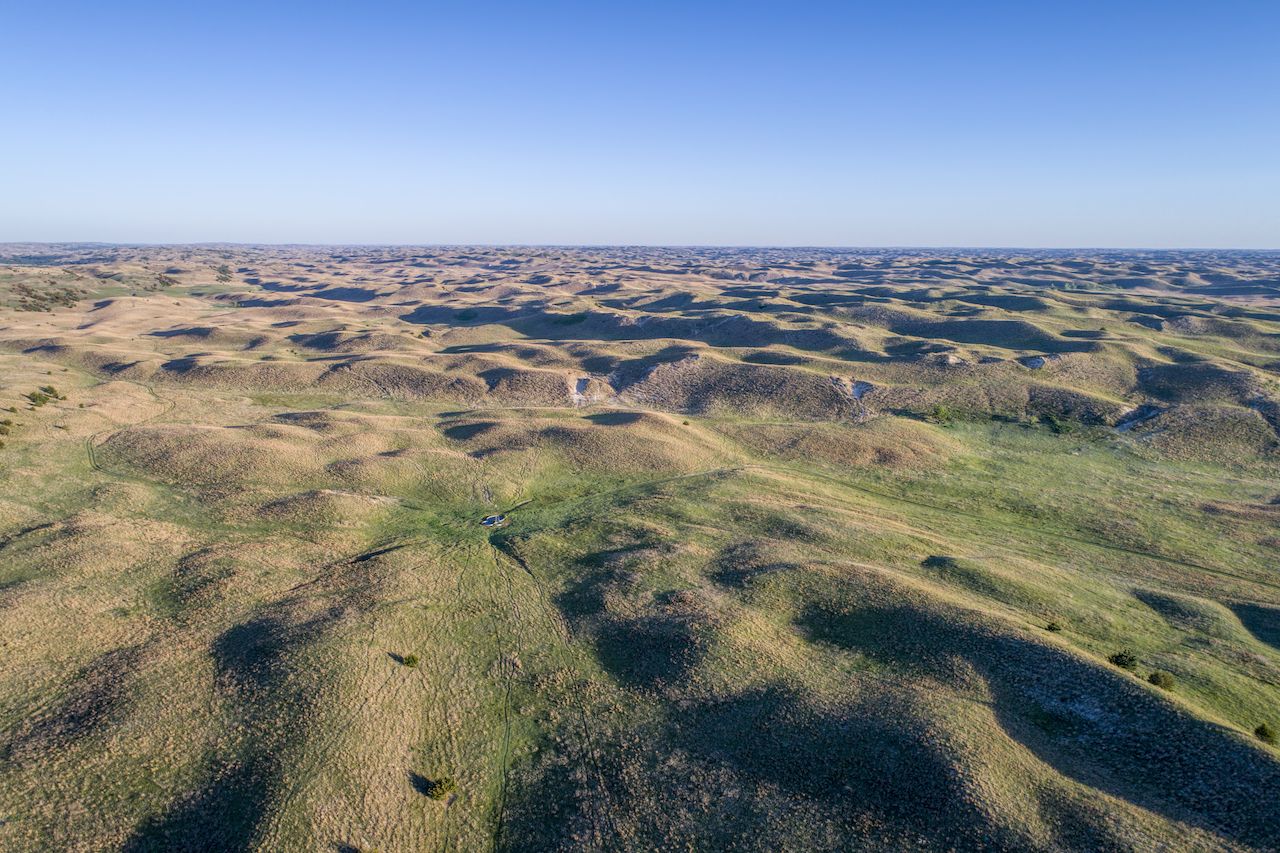
Photo: marekuliasz/Shutterstock
Victoria Springs State Recreation Area is well-removed from the I-80 flood headed through Omaha and Lincoln, making it an ideal spot for two things: wide-open spaces to sleep under the stars and plenty of country seclusion. Nebraska takes its fishing and casual boating seriously, and this recreation area in the Sand Hills is among the best places in the state to do both, at the same time.
For camping, your options are diverse. Do it raw in your tent, park an RV at one of almost two dozen pad spots, or rent a cabin. Basic spots run $15, and it’s $30 for a full hook-up. Sand Hills is an ideal spot to test out that flannel you haven’t had the guts to wear to the coffee shop by your apartment. It’s full-on Midwest-wild here, which means all pretension is left at the edge of city limits.
28. Nevada: Lake Tahoe
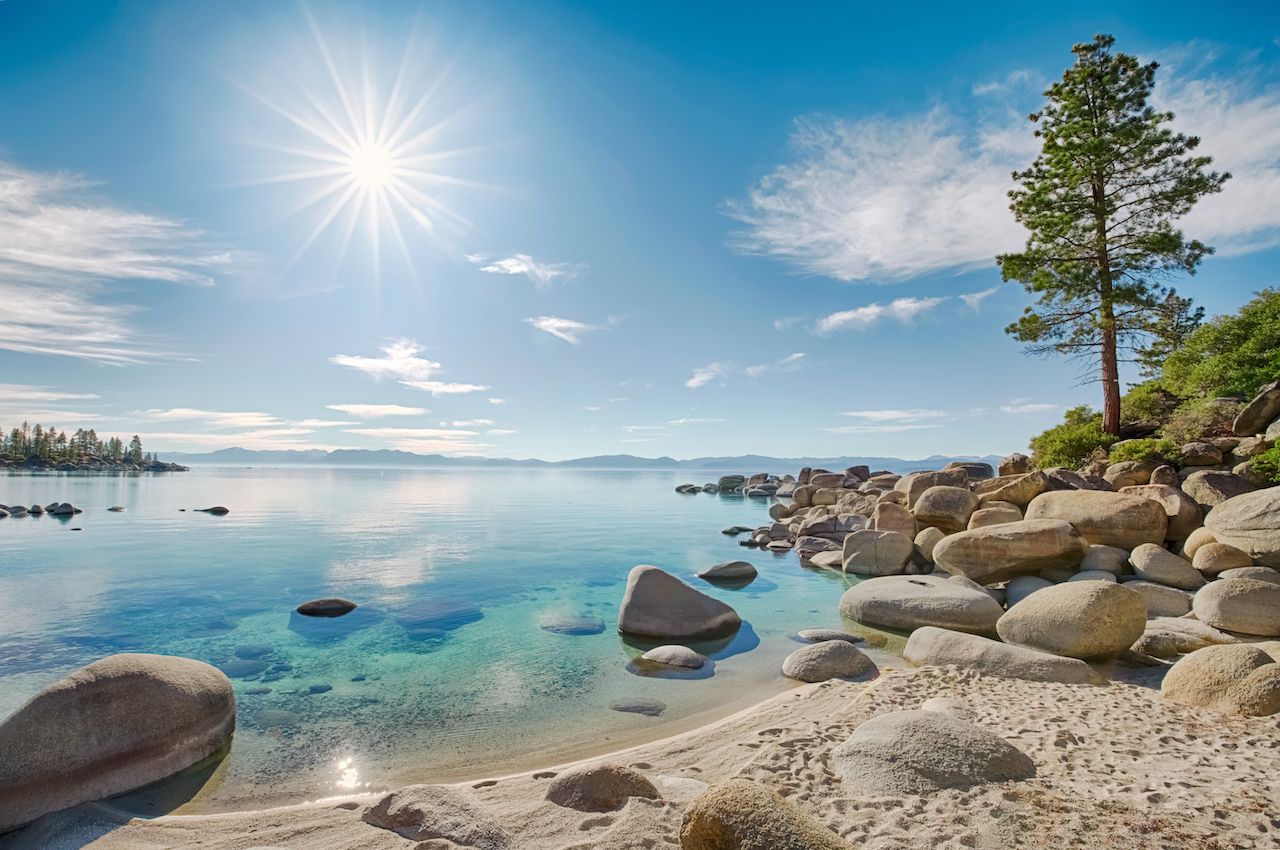
Photo: topseller/Shutterstock
While the neon lights of Las Vegas may be what come to mind when you think of Nevada, you can’t forget Nevada has some incredible natural wonders to offer up as well. And the state also shares one of the country’s most stunning lakes with its neighbor, California. Over 6,000 feet above sea level and ringed by the Sierra Nevada range, Lake Tahoe is the largest alpine lake in North America. At over 1,600 feet deep, it’s also the second deepest. As you approach the depths, Tahoe’s color is a mesmerizing cobalt blue. At the water’s edge, though, the lake is crystal clear.
It’s one of the world’s most beautiful places to paddleboard or kayak, and if you head up into those mountains you can access world-class hiking and mountain biking. A stunning place to pitch your tent is the Nevada Beach Campground, tucked into a native pine forest, just a short walk to the lakeside beach. It’s popular, so reserve your spot early.
29. New Hampshire: Crawford Notch State Park
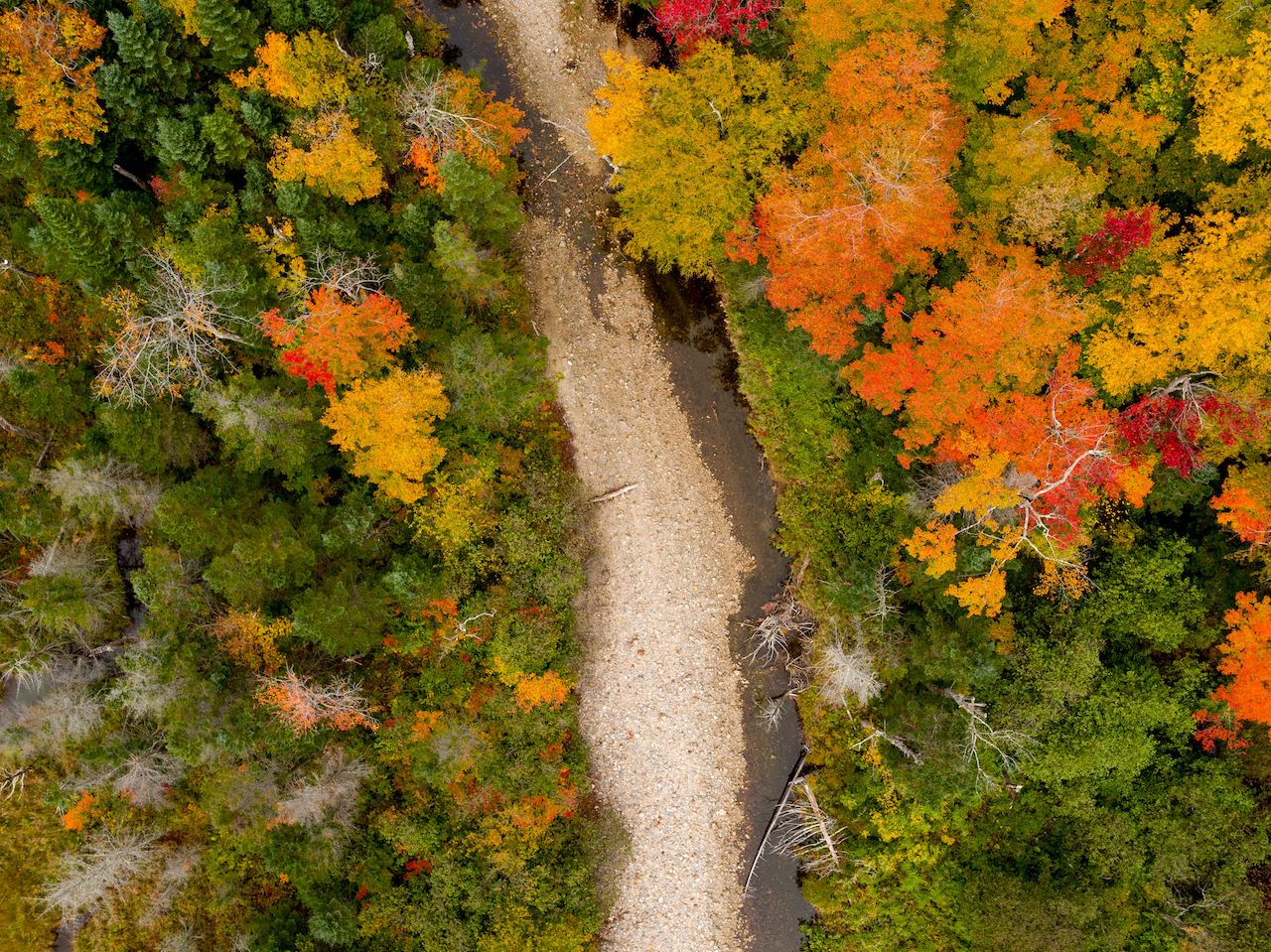
Photo: Christopher Georgia/Shutterstock
There are a few theories for why New Hampshire’s White Mountains are called as such. The most obvious is that they are a snow-covered wonderland in the colder months. Another hypothesis is that early European settlers were impressed by the way many of the mountain’s exposed granite peaks gleamed in the sunshine. A third possibility is that the distinctive white bark of birch trees, the New Hampshire state tree, is ubiquitous in the forests that blanket the mountains. Whatever the reason, the colors that this area brings to mind in the warmer months is not in fact white at all, but green and blue. The glacier-carved region is a series of gently sloped peaks covered in verdant forests, lined by rivers and dotted with azure lakes.
If you had to pick a spot in the White Mountains, you could do worse than the 5,800-acre Crawford Notch State Park, which has miles of hiking and mountain-biking trails, quite a few of which lead to waterfalls that cascade down exposed rock faces. The park’s campground at the Dry River is your choice there.
30. New Jersey: Wharton State Forest
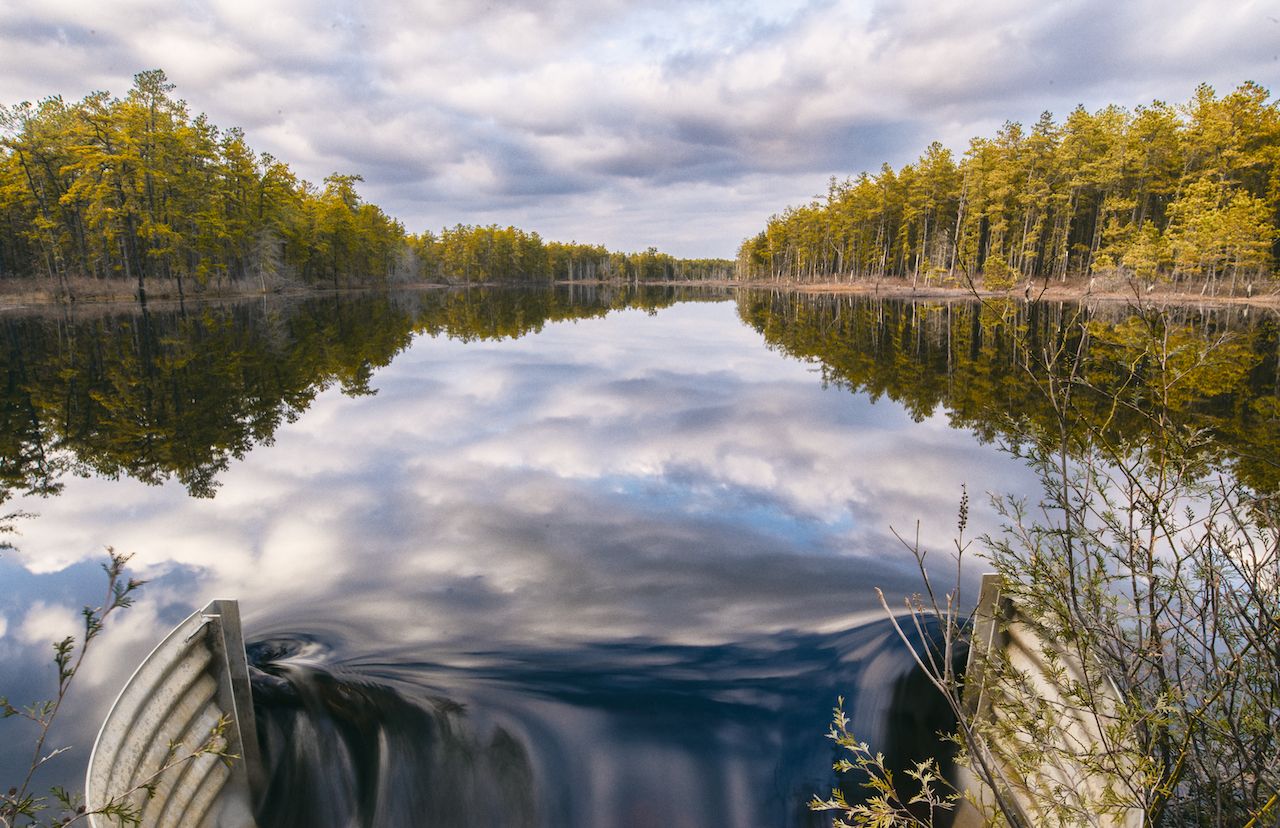
Photo: Zhiwei Huang/Shutterstock
The largest state forest in New Jersey is crisscrossed with hiking, mountain-biking, and horseback-riding trails, as well as rivers, lakes, and ponds. It’s an excellent place to bird watch, as it’s home to martins, goldfinch, ospreys, and bluebirds. You’ll see great blue herons wading and swans gliding, and if you look up you may spot a hawk and even a bald eagle soaring above. Other wildlife include the beavers and river otters that thrive in the park’s waterways. You’ll find plenty of primitive camping among the state forest’s 123,000 acres and more developed camping with fire rings, picnic tables, and nearby shower facilities at its Atsion campground.
31. New Mexico: Gila National Forest
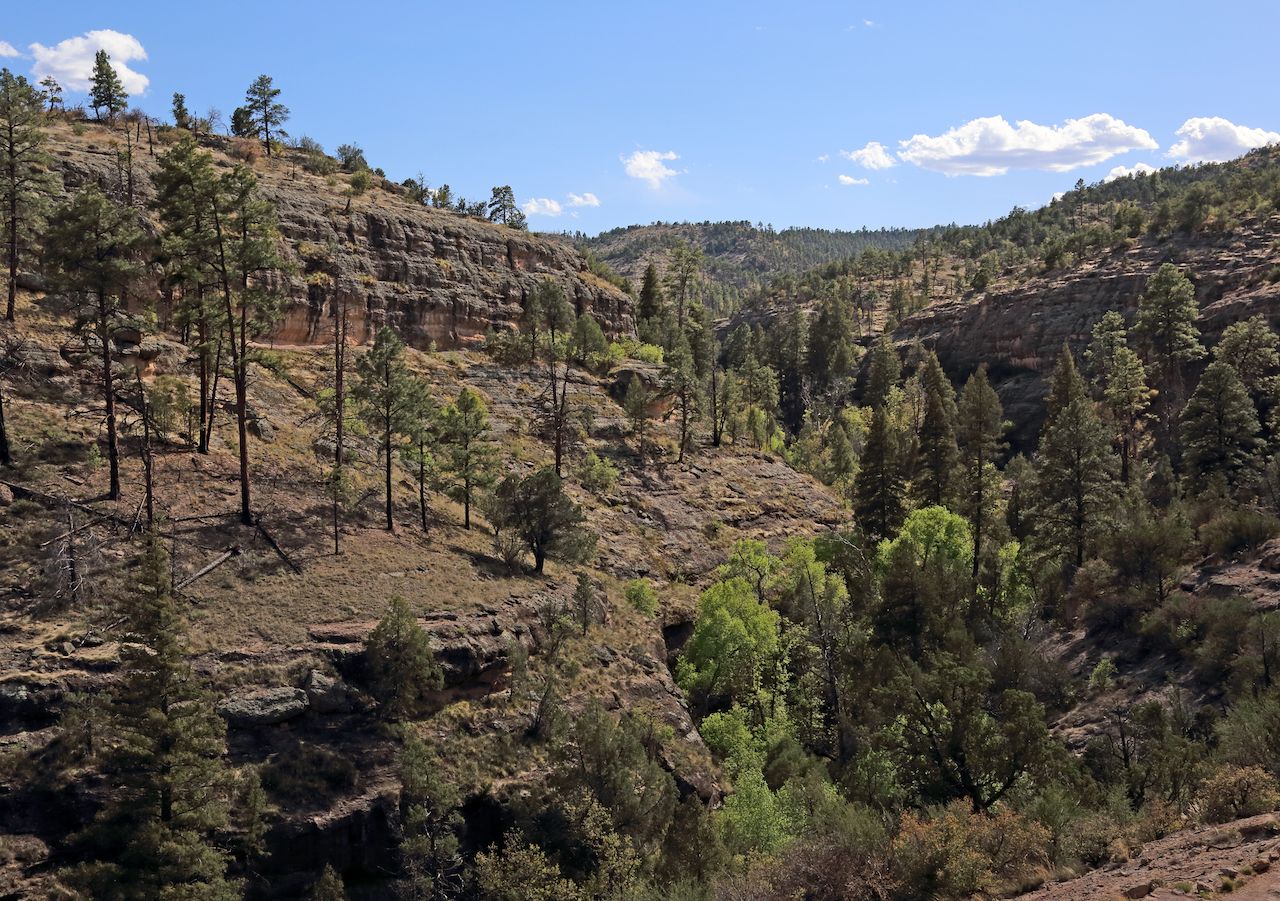
Photo: Chris Hill/Shutterstock
The West lives on eternally outside of Silver City in the Gila National Forest, among the most iconically “wild” places left in the Lower 48. Here you’ll find 3.3 million acres thick with spruce, cottonwood, oak, and more creating a forest canopy that offers shaded hiking trails and even a dark sky sanctuary.
You’ll never have to worry about not getting a spot in or around the Gila National Forest. Camping options are scattered across over 40 — yes, 40 — campgrounds, and no reservations are needed or accepted. Plus, many of the campgrounds are free, so spend that extra few bucks to take your campfire dinner over the top. Additional dispersed camp spots are scattered throughout the forest, and you can, of course, exercise your public land ownership rights and utilize open space for backpacking, as long as signs don’t direct otherwise.
32. New York: Adirondack Mountains

Photo: Colin D. Young/Shutterstock
People accustomed to skiing in New Hampshire and Vermont might forget that the 1980 Winter Olympics were actually held in Lake Placid, smack in the heart of the Adirondacks. You can in fact visit a lot of the sites from the Olympics, like the ski jump; it never fails to awe that someone would actually launch themselves off something so high. The Adirondacks also have some of the best hiking, biking, and camping this side of the Mississippi, as well as a varied selection — 3,000 of them, in fact — to canoe on, swim in, or simply admire from the shore.
The area’s tallest mountains are called the High Peaks. You can backcountry camp in most of the forest preserve land of the High Peaks areas, unless they’ve been designated Unique Lands. Or camp lakeside at campgrounds like the public Saranac Lake Islands Campgrounds. The good news is you can drive there, but still wake up just steps away from the stunning lakeside.
33. North Carolina: Outer Banks
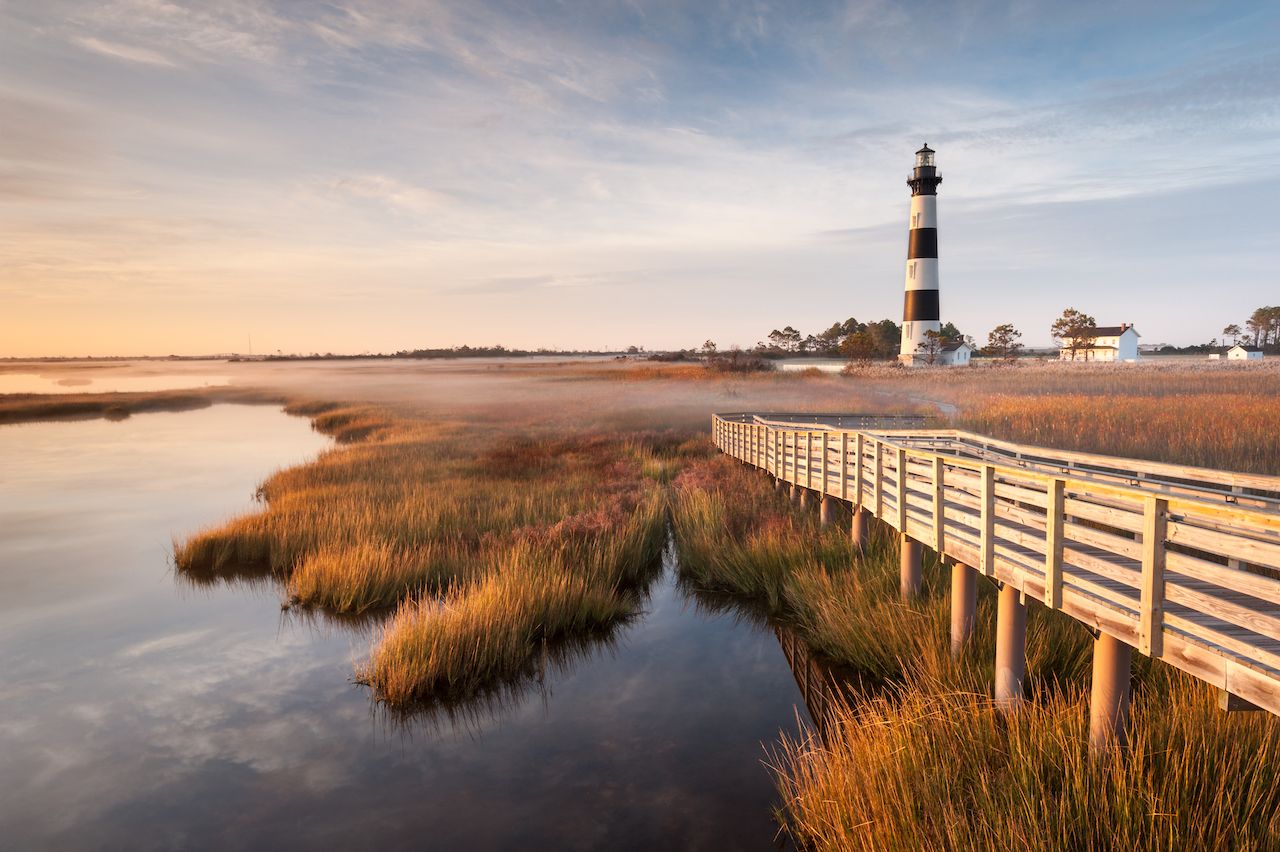
Photo: MarkVanDykePhotography/Shutterstock
Remote beach camping is the name of the game in the Outer Banks, at least to those with a nose for solitude. Options span from Carova Beach and Cape Lookout, both with nearby surf breaks, to the remote campgrounds on Roanoke Island. Kitty Hawk Woods Campground and selected designated areas just off the beach offer RV-friendly sites, though the best beach camping experience is to pop your tent in the soft sand and listen to the waves crash. Keep in mind that when camping on the beach, fires can only be built below the high tide line.
There’s also a lot of history in the area if you’re into venturing away from the campsite. A must-do during your camping expedition is the Wright Brothers Memorial, which pays tribute to the legends of flight. If you’re camping with kids, stop by the North Carolina Aquarium to learn about local sea life.
34. North Dakota: Theodore Roosevelt National Park

Photo: Steve Bower/Shutterstock
Theodore Roosevelt National Park embodies the best qualities of outdoors life in the northern Midwest: grassy hills, bluffs, river canyons, wildlife, and skies that go on forever. Here, you have the added bonus of it being a national park, which means ample hiking, family activities, and protected spaces, including the Badlands Overlook and the Chateau de Mores State Historic Site and Museum.
The park has two campgrounds, both of which are primitive — meaning no running water, waste disposal, or hookups. Use this to your advantage by disconnecting fully from the outside world (read: stay offline and wait to post photos until you return to civilization). This will give you that much more energy to expend on grilling campfire food, hiking the Maah Daah Hey Trail, or playing in the river.
35. Oklahoma: Chickasaw National Recreation Area
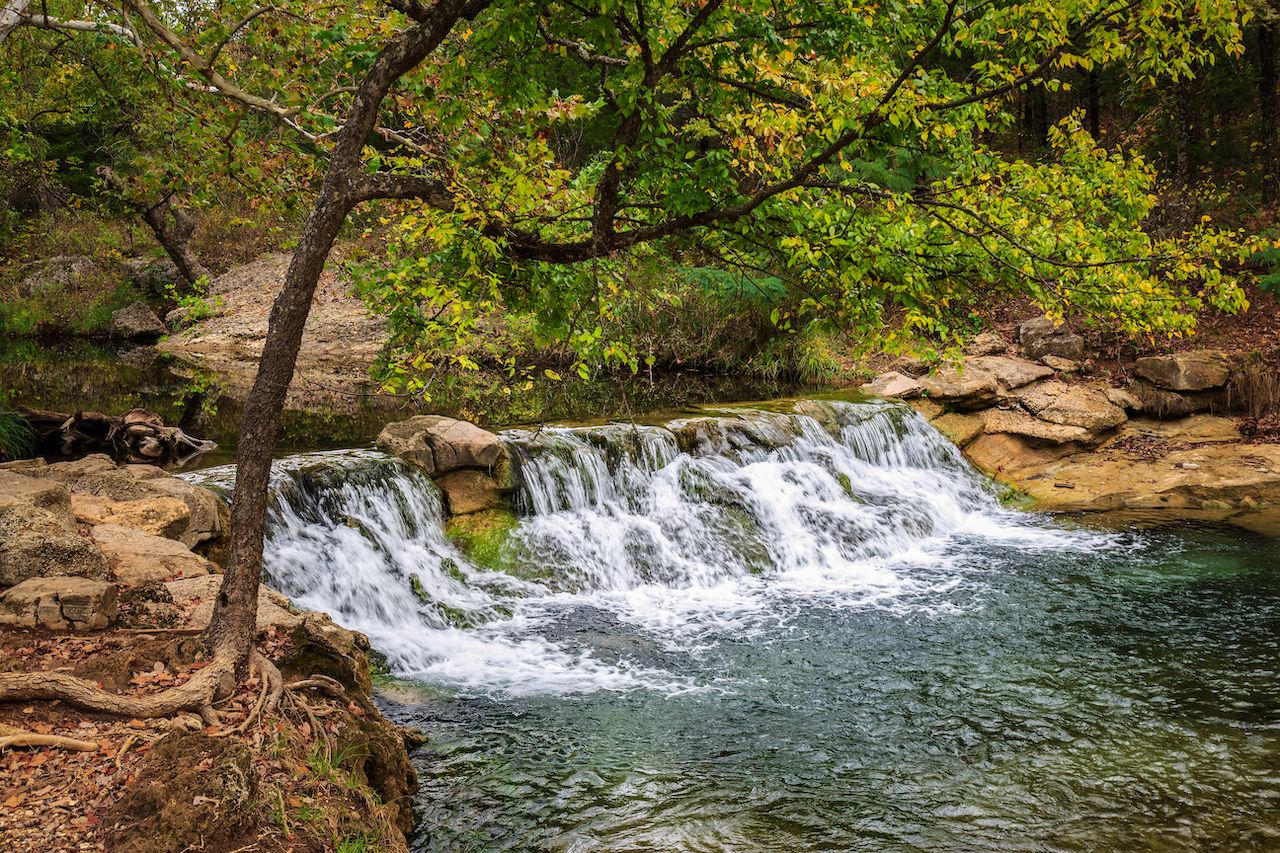
Photo: crotonoil/Shutterstock
Chickasaw National Recreation Area is unique in that its rivers and topography allow for one of life’s simplest pleasures: the hidden swimming hole. Lots of them. Lake of the Arbuckles is one of the best fishing spots in Oklahoma, and camping alongside it means you don’t have to jostle for a spot to cast your line. Pitch a tent at The Point campground and take advantage of their lakeside facilities to cook, jam around the fire, and sleep. It’s the prettiest and cheapest of the campsites in the area, at just $16 per night.
Camping at Chickasaw is easily accessible from both Oklahoma City and Dallas. The lake is huge — you can get out on a boat or paddle your way out as far as you’re comfortable from The Point and gaze up at the open sky. If camping with kids, stop by Travertine Nature Center to explore the exhibits and listen to staff talk about the surrounding Platt Historic District, part of a former national park.
36: Ohio: Hocking Hills
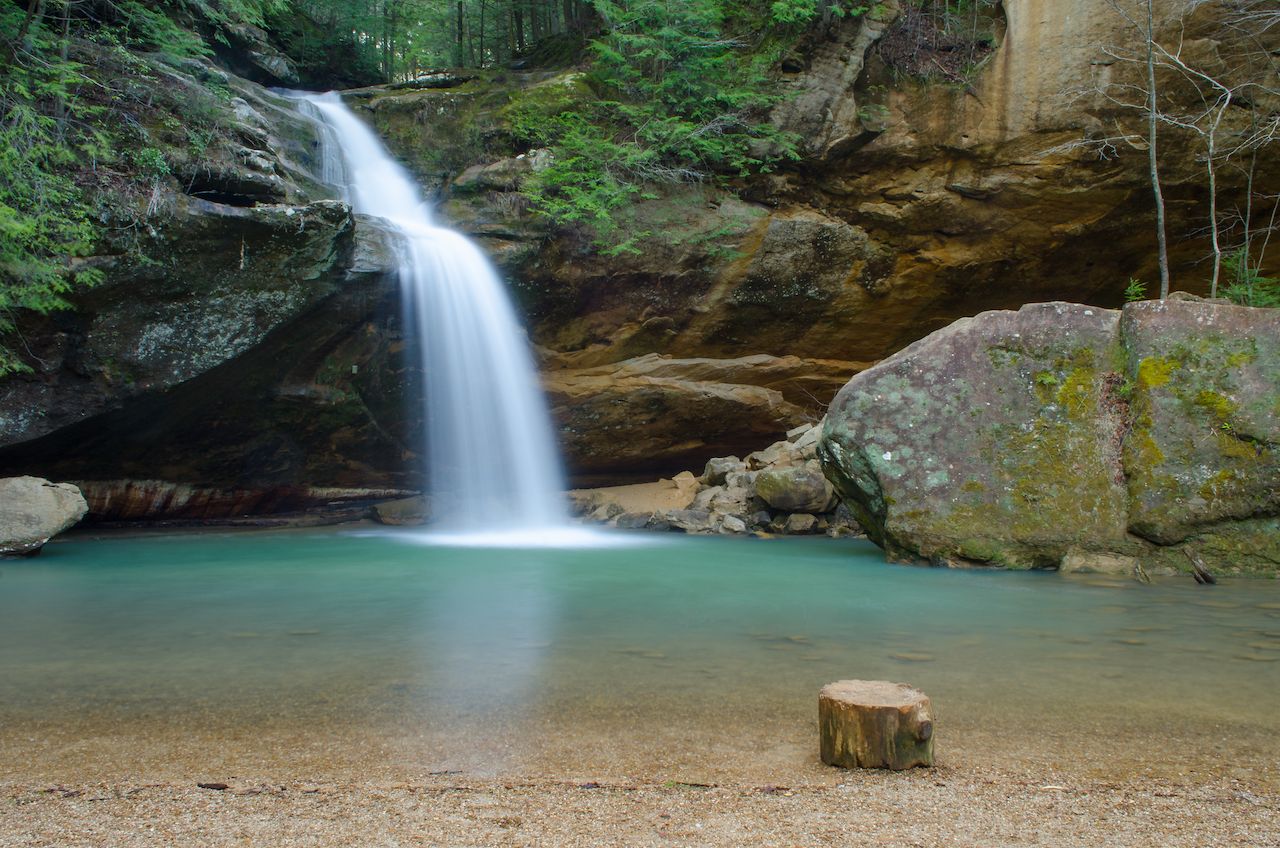
Photo: Ross Ellet/Shutterstock
Hocking Hills in southern Ohio may be best-known for its stunning waterfalls, but it has plenty of other eye-catching natural features. One of the most awe-inspiring among them is Ash Cave, a massive recess cave with a towering waterfall flowing from the top — reached by hiking along a beautiful, wooded gorge. Old Man’s Cave is another noteworthy grotto in a region packed with cascades, caves, and topographical marvels.
Activities in Hocking Hills include hikes through lush forests, canoeing, swimming, rock climbing, and, of course, camping under the stars. Hocking Hills comprises a large area of multiple state parks with numerous places to stay. The Old Man’s Cave Campground in Hocking Hills State Park is one of the most popular places to pitch your tent.
37: Oregon: Harris Beach State Park
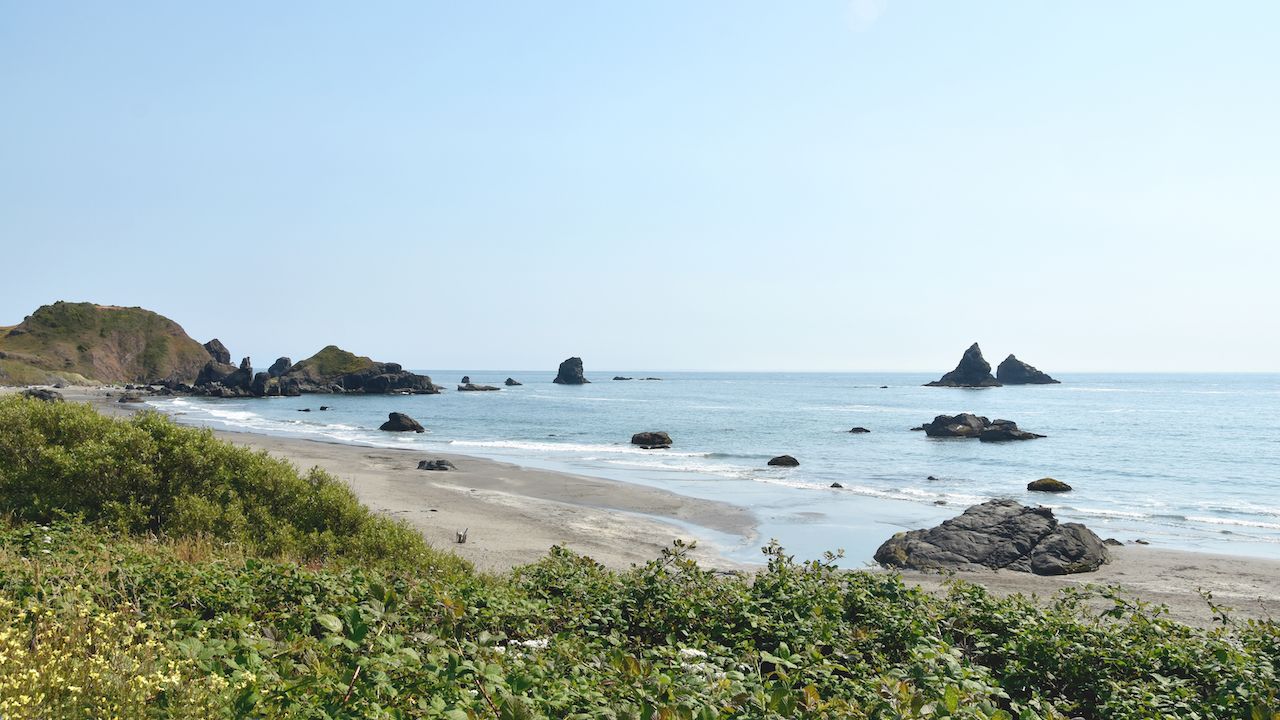
Photo: Muriel Lasure/Shutterstock
Walking along the bluffs, rocks, and hidden beaches of the craggy Oregon coastline is the perfect way to experience coastal life, Pacific Northwest style. And Samuel H. Boardman Scenic Corridor is the best place in Oregon to do so. Here, 18 miles of hikeable coast and rock lead to scenic viewpoints including Arch Rock, Natural Bridge, and the Cape Ferrelo Viewpoint, all accessible via short walks.
Harris Beach State Park, just south on the Oregon Coast Highway, offers camping for tent campers as well as RVs. More than 100 campsites are available, 65 of which are full hook-up. Tent sites are $20, hook-up sites are $30, and for the best experience, reserve your spot in advance.
38. Pennsylvania: Laurel Highlands

Photo: CMS Photography/Shutterstock
As the name suggests, Laurel Highlands has the tallest elevation of any area in Pennsylvania, enjoying cooler temperatures than most of the rest of the state. This region of southwest Pennsylvania has several historic areas dating to the founding of the country, from estates to battlefields. It’s also packed with state parks that cover 120,000 of its acres. Beyond swimming, fishing, and mountain biking, Laurel Highlands has some of the best hiking in Pennsylvania.
The 70-mile Laurel Highlands stretches from one of those state parks, Ohiopyle State Park, to the Conemaugh Gorge, which slices through the Laurel Hill Ridge. Other state parks include Laurel Hill and Keystone state parks. Lakeside campground is a beautiful place to stay in Keystone Park, while we’d recommend the Kentuck campground in Ohiopyle.
39. Rhode Island: Burlingame State Park
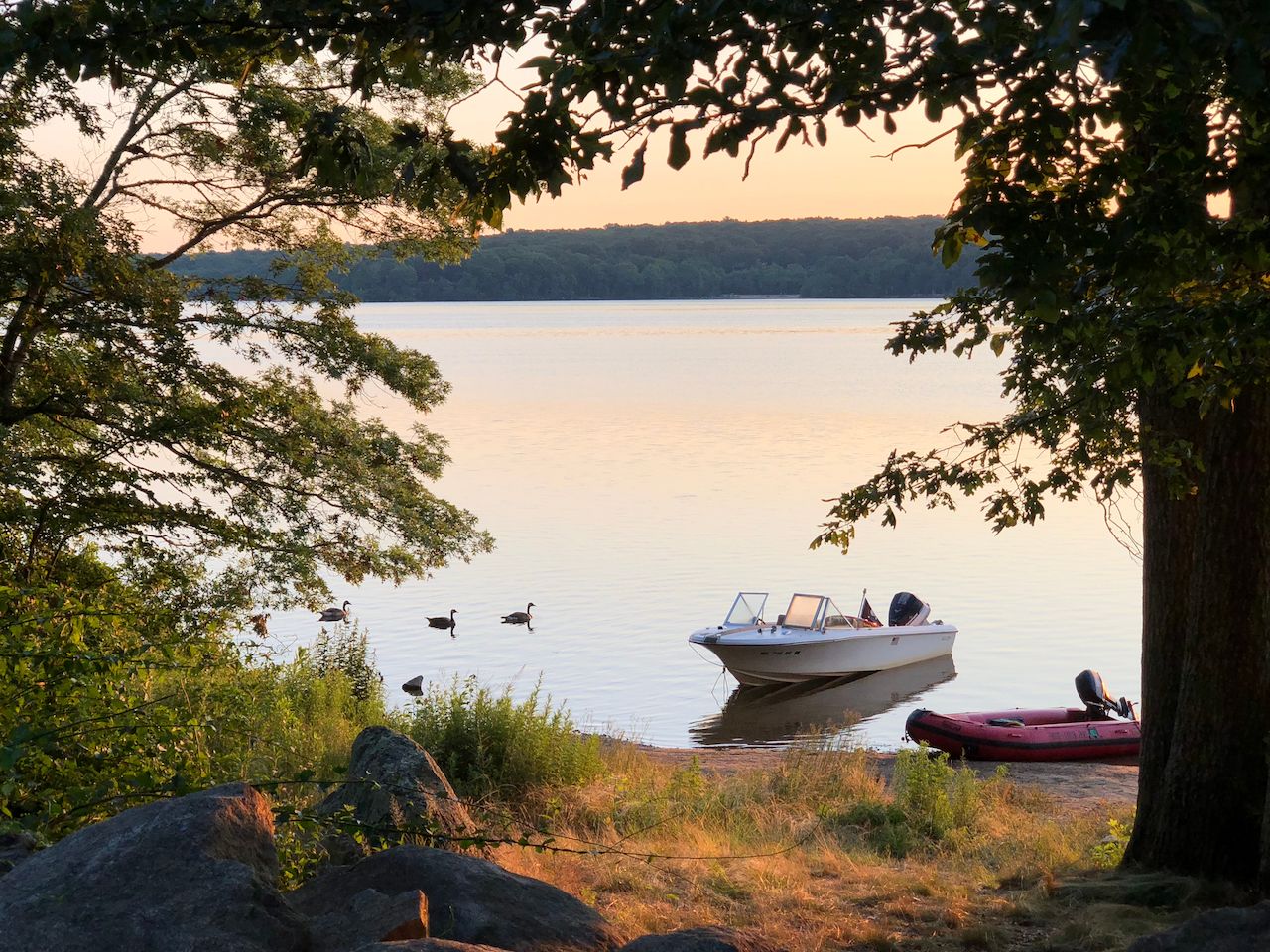
Photo: Susilee Dean/Shutterstock
In a state whose very name evokes water, you want to stay at a campground that lets you wake up and jump right into said water — not a bad way to start a summer day. And while the coastal campgrounds at East Beach and Charleston Breachway give you immediate access to the Atlantic waters of the Block Island Sound, camping there is reserved for RVs. Enter Burlingame State Park, which lies just inland from East Beach. The campground has over 700 campsites spread over more than 3,100 forested acres along the shores of Watchaug Pond.
That means you can wake up by the water for your freshwater swim or paddle in a rented canoe. You could also hike or bike your way to the ocean itself or to Ninigret Pond and the Ninigret National Wildlife Refuge, home to marshes, wetlands, and over 250 species of birds.
40. South Carolina: Hunting Island State Park

Photo: DMS Foto/Shutterstock
South Carolina’s largest state park is a 5,000-acre barrier island of semi-tropical maritime forest lapped by warm Atlantic waters. Loggerhead turtles, egrets, and herons are just some of the wildlife you’ll appreciate in the park, along with five miles of beaches and a saltwater lagoon. A climb up to the Hunting Island Lighthouse gives you a bird’s-eye view of the park’s pines, live oak, and cabbage palmetto trees, and the Atlantic Ocean. The park’s 100 campsites all have water and electrical hookups and are popular all year — reserve on the South Carolina state park page.
41. South Dakota: Custer State Park
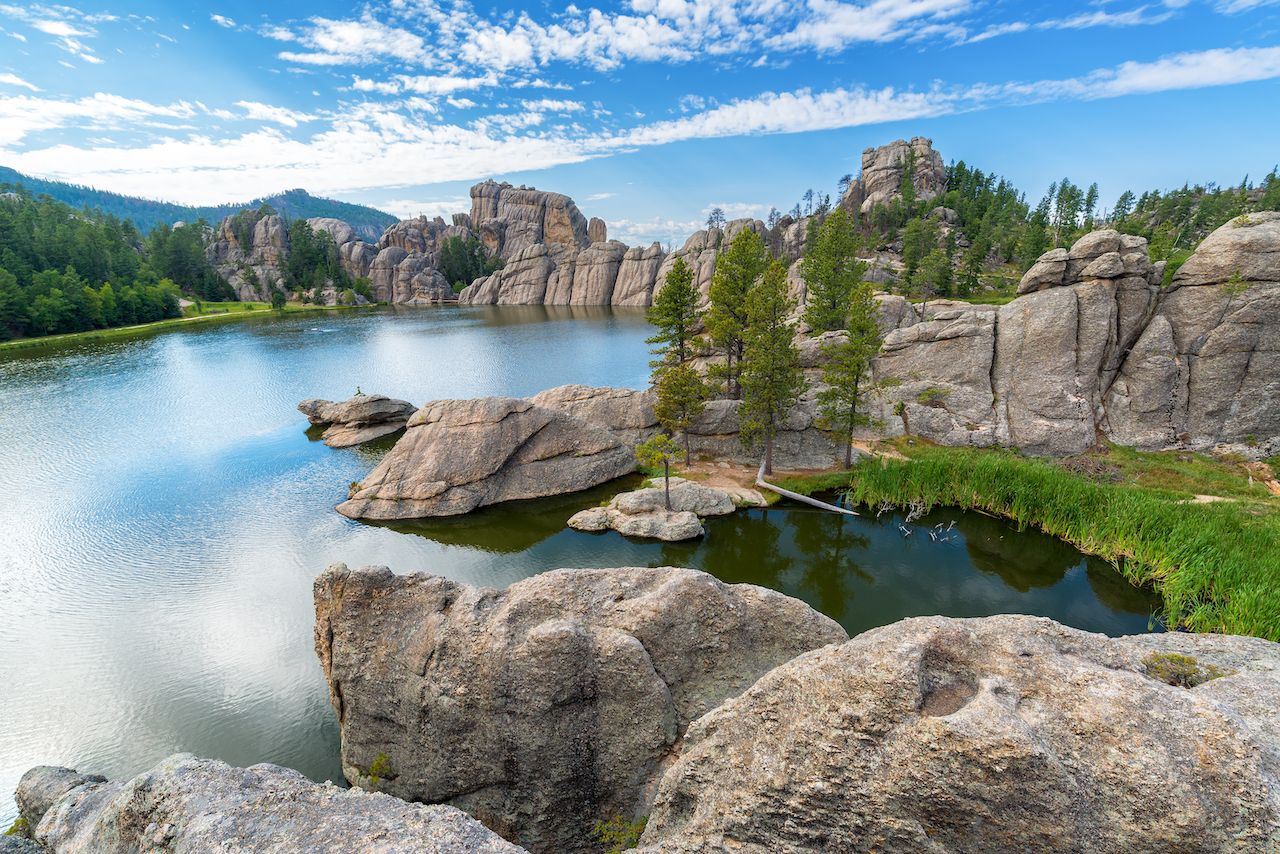
Photo: Jess Kraft/Shutterstock
South Dakota’s Black Hills encompass sweeping forests of ponderosa pine punctuated by startling granite peaks that seem to emerge out of nowhere. Lying among these hills is Custer State Park, the largest state park in South Dakota and home to over 1,500 bison. In addition to the bison, you’ll see elk, deer, mountain goats, bighorn sheep, and prairie dogs in the park, and, with luck, you may spot more elusive creatures like cougars. You can hike or mountain bike to those eerie gray peaks, or work your way to one of the park’s five lakes to swim, paddleboard, canoe, or fish — and spend the evening by the campfire recounting your day at one of nine campgrounds. Of these, Center Lake campground, tucked into the pine trees just above the lake and its swimming beach, with showers and toilets, is a great choice for families.
42. Tennessee: Great Smoky Mountains National Park

Photo: Dave Allen Photography/Shutterstock
You really haven’t visited Tennessee unless you’ve spent some time in Great Smoky Mountains National Park, a 500,000-acre wonder in the southern Appalachians. The park has over 800 miles of trails that snake up from its valleys towards its famously mist-covered peaks — including its highest, 6,643-foot-high Clingmans Dome. Beyond hiking, you can fish in any of the park’s streams all year; you’ll just have to purchase a Tennessee fishing license outside the park before you arrive.
As to be expected in such a renowned national park, you have all kinds of options for RV, backcountry, or drive-up camping, which you can do in ten different places in the park. If you want a small campground far from the bustle, the park’s Abrams Creek area has only 16 individual sites and is close to fishing and trails. If you want mountain vistas, the much larger Smokemount campground lies at 2,200 feet and offers stunning views.
43. Texas: Enchanted Rock State Natural Area
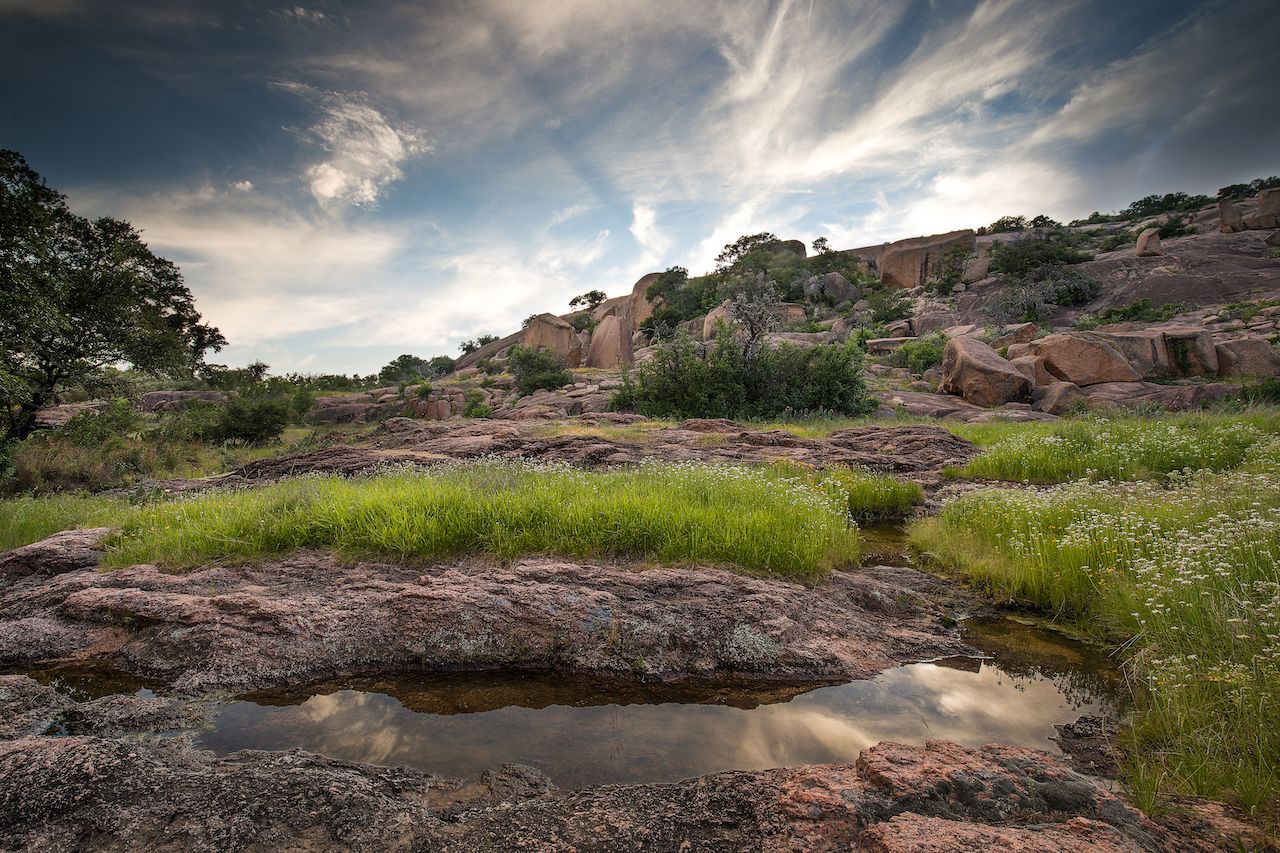
Photo: Jason Squyres/Shutterstock
Texas Hill Country has been enjoying a lot of well-deserved attention of late. Not only are there rolling hills blanketed in wildflowers in the spring, there are excellent opportunities for road-biking and multiple state parks with trails for hiking. Add in over 100 wineries, and you soon understand what all the fuss is about. Of those 100 wineries, fully half are in the county that surrounds Fredericksburg, and it’s here that we recommend you camp.
Set up your tent in the Enchanted Rock State Natural Area, named for the rose-hued, granite rock that emerges from the ground. You hike up to the rock, and another several more miles of trails wind through the park; rock climbing and bird-watching are other popular options. One of the things about camping here, though, is that the state park is an officially designated International Dark Sky Park. What a better way to enjoy the night sky than outdoor by the campfire, with a glass of Hill Country Malbec in hand?
44. Utah: Grand Staircase-Escalante National Monument
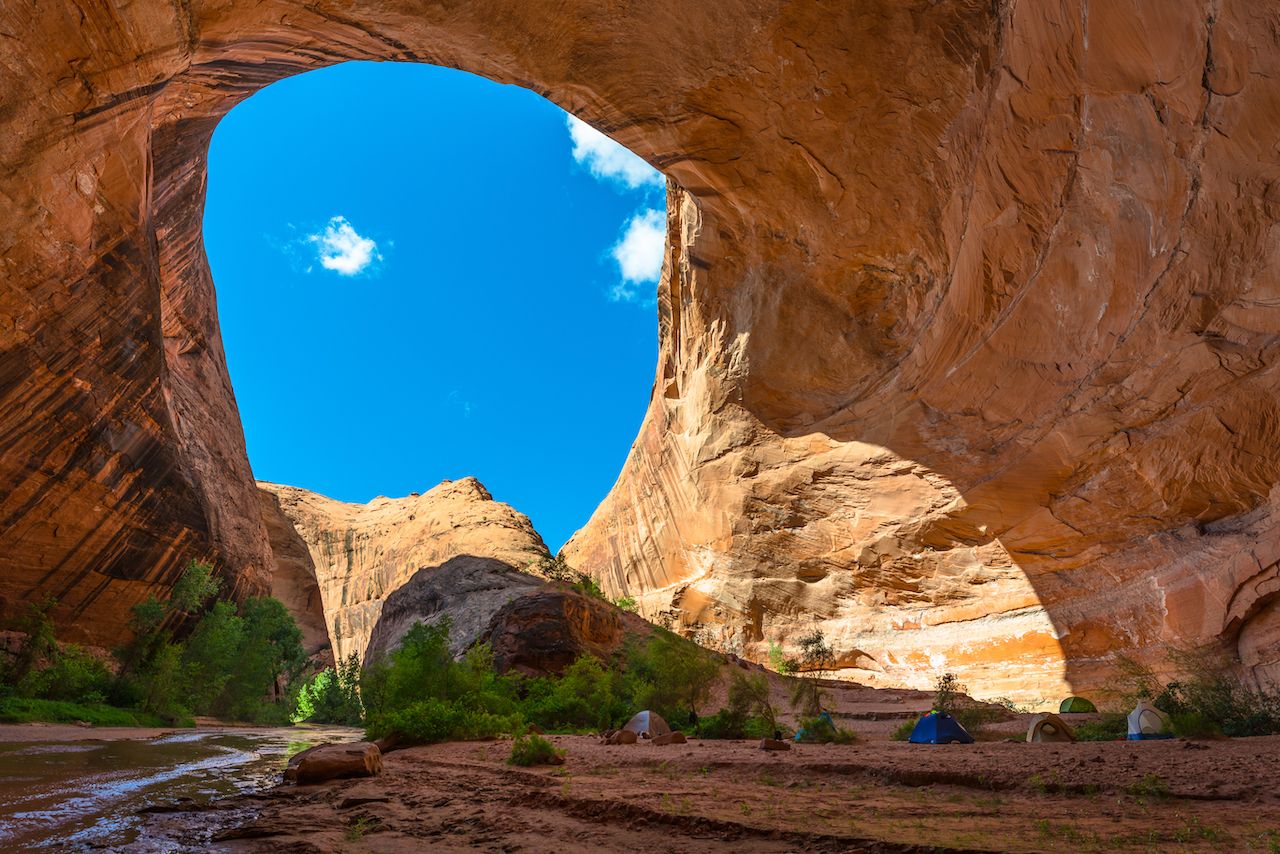
Photo: Kris Wiktor/Shutterstock
If we were to nominate a single state for its sheer camping glory, few would come close to Utah. The problem then becomes where to go. Might we suggest the immediate surroundings outside the town of Escalante, and Calf Creek Campground within Grand Escalante-Staircase National Monument in particular. From here you’ll have easy access to Calf Creek Falls via a moderate hike, plus the surroundings of the monument at large. You’re also sticking up for public lands by camping here, as Grand Staircase-Escalante has been at the center of debate since President Trump announced plans to drastically reduce its size shortly after taking office. Not to mention that the drive in on Route 12 is a stunningly beautiful experience in itself.
There are 13 campsites at Calf Creek Campground, all first-come, first-served, for $15 per night. Should you decide to toss your other life plans to the side in Ed Abbey-esque fashion, Southern and Eastern Utah is an area that could keep you busy for a very long time. To the north are Capitol Reef, Arches, and Canyonlands National Parks. To the south is Glen Canyon National Recreation Area. And then there’s Vermillion Cliffs and the Grand Canyon . . .
45. Vermont: Smugglers Notch State Park
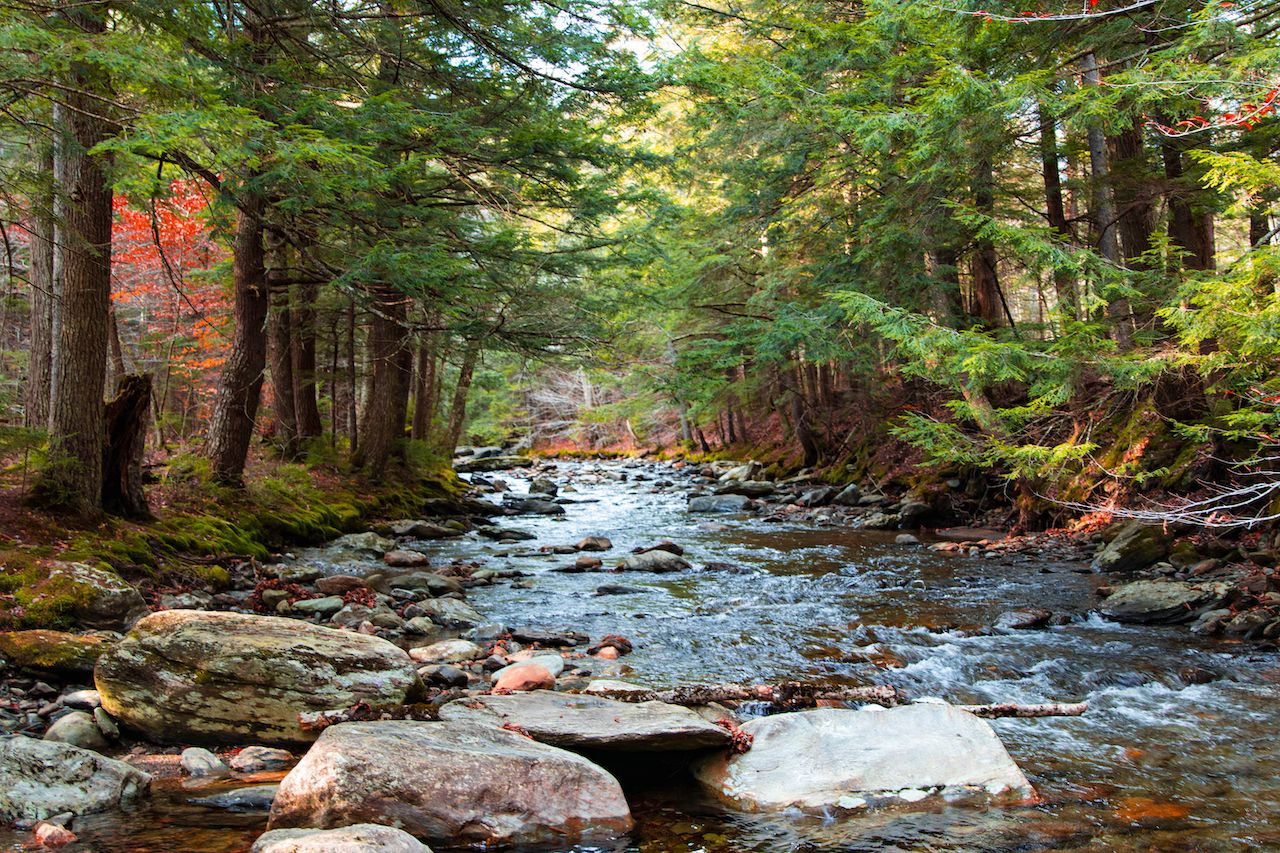
Photo: Jessica Mae Gonzaga/Shutterstock
Vermont teems with beautiful spots. We’ve chosen Smuggler’s Notch State Park because it’s not only a stunning location but because it has an intriguing history that’s hinted at in its name. The park at the northwest corner of the Vermont near Stowe was a pass-through point for goods smuggled between Vermont and Canada after the US passed the 1806 Embargo Act and later became a point in the underground railroad that smuggled slaves all the way to Canada. Later still, it functioned as a way-point for alcohol smuggled in from Canada during Prohibition.
Besides contemplating the alternately nefarious and noble goings-on that occurred here, a mere 40 miles from the northern border, you could go hiking, biking, bouldering, or exploring some of the caves nature built into the granite peaks. The lovely park in Vermont’s Green Mountains accesses the many trails of nearby Mount Mansfield State Forest as well. The campground has 20 sites and 14 lean-to sites.
46. Virginia: Shenandoah National Park

Photo: Jon Bilous/Shutterstock
Perhaps the first thing that strikes you when you visit Shenandoah National Park is just how lush it is. This 200,000-acre park spread out over the southern Appalachians is over 95% forested — with red oak, chestnut, birch, ash, and maple trees making up just some of the tree species spread out over its ecosystem. With peaks that reach 4,000 feet, Shenandoah supports a variety of habitats, in addition to offering incredible viewpoints you can hike to along some of its 500 miles of trails. Many of those viewpoints are on rocky outcroppings, a geological feature that draws rock climbers from throughout the area.
Birdwatchers will have nearly 200 species of birds to watch out for, and pretty much anyone will be able to spot white-tailed deer; the park’s resident brown bears and bobcats are more elusive. There are also three trout species you can fish for in certain locations. The park has five campgrounds, four of which you can reserve up to a year ahead. Its smallest campground, Lewis Mountain, is first-come, first-served. If you’re hoping to camp in the backcountry, start your permitting process at least two weeks in advance.
47. Washington: Olympic National Park

Photo: Galyna Andrushko/Shutterstock
Olympic National Park in western Washington feels like someone took the snow-covered peaks and alpine lakes of Switzerland and placed them next to the intense swells of the northern Pacific Ocean. Add in a little bit of New Zealand as well, in the form of lush temperate rainforests where bright green moss clings to every trunk and tree branch. Naturally, the list of things to do here is just about endless, from tidepooling at sea level to hiking up to the park’s tallest peak, the 7,800-foot-tall Mount Olympus.
Fortunately, there are 14 campsites in the park, so you can spend as much time as you like soaking in some of Mother Nature’s best work and deciding how to spend your time here. Depending on what kind of environment you’re looking for, there’s a campsite for you — perhaps near the towering ancient trees of the temperate rainforest or near a blue mountain lake. Reservations are needed for the Kalaloch, Sol Duc, and Mora campsites, and the rest are first-come, first-served.
48. West Virginia: New River Gorge

Photo: Kenneth Keifer/Shutterstock
New River Gorge National River is one of the most stunning places in a state packed with rolling hills and leafy forests. One of the oldest rivers in the world slices through the area’s 63,000 acres, and over 1,400 climbing routes beckon rock climbers to its hard sandstone cliffs, some of which reach 120 feet in height. Hiking and mountain-biking trails also crisscross the area, but the real draw here is the ancient river itself, which is a top spot for fishing and whitewater rafting. The National River area has seven primitive camping areas, meaning there’s no running water or other facilities. But you can find more developed campgrounds just south of the park at the 4,000-acre Babcock State Park.
49. Wisconsin: Turtle-Flambeau Scenic Waters Area
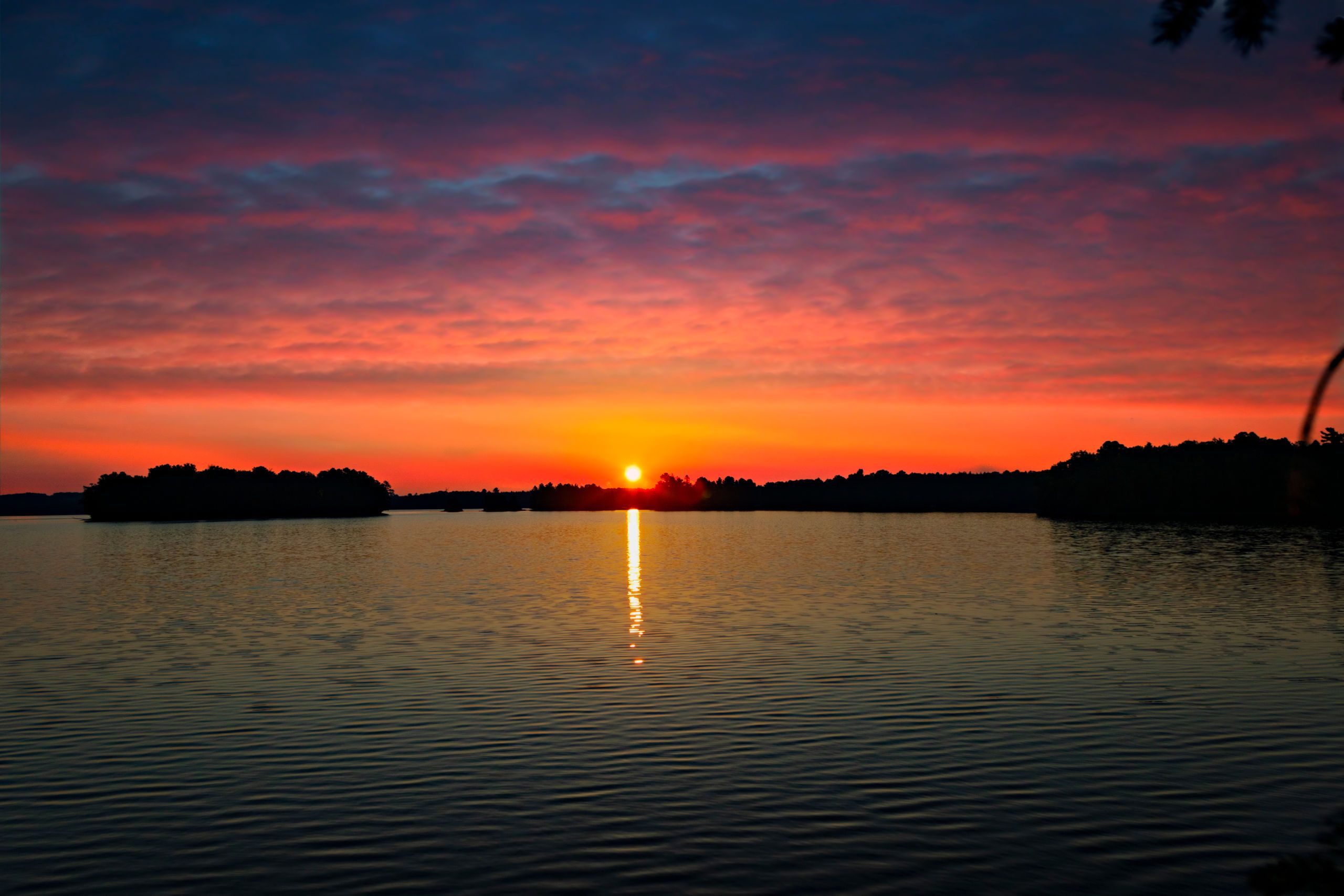
Photo: Karel Bock/Shutterstock
Turtle-Flambeau Scenic Waters Area is Wisconsin’s version of the Boundary Waters. Campsites accessible only by canoe dot the coves and islands of the “Flambeau Flowage” — 66 in total, available on a first-ashore, first-asleep basis. The area is made up of a series of islands, headlined by the aptly titled Big Island, with the campsites scattered across them. Once you have your spot, head back out on the water to canoe around the flowage area, pulling off to hike the two-mile Hidden Rivers Nature Trail before paddling back to camp.
Keep your eyes peeled for bald eagles, deer, osprey, and other wildlife, as you’re likely to spot them from afar while on the water. You’ll need to buy a parks pass upon entering the park, which grants permission to access the campsites.
50. Wyoming: Bridger-Teton National Forest
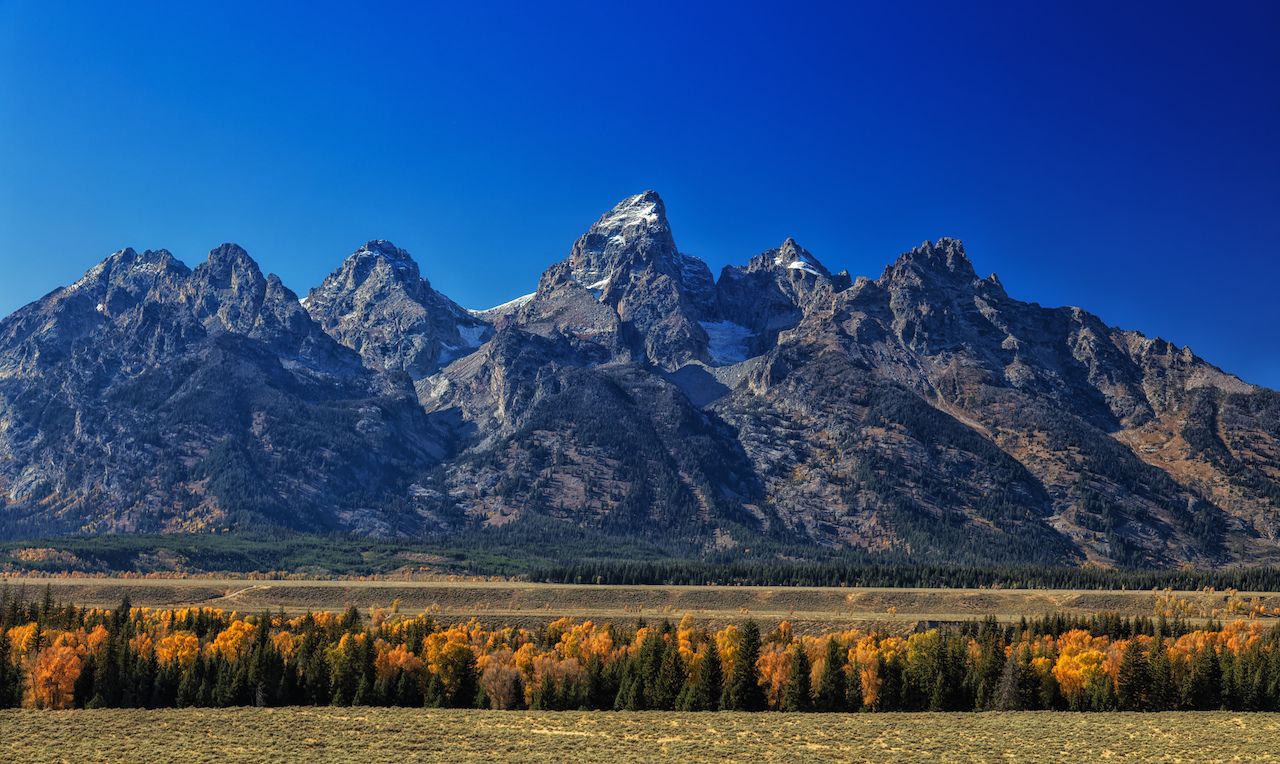
Photo: Mitch Johanson/Shutterstock
The spires of the Grand Tetons are among the most iconic images of America’s National Parks. Both Teton and Yellowstone National Parks are worthy for building a road trip itinerary around, but to avoid the chaos that the Jackson area becomes in summer months, pop a tent in the Bridger-Teton National Forest. More than two dozen campgrounds are available in the forest, as well as dispersed spots outside of campground boundaries. Reservations are generally not needed, nor is the tedious task of removing your wallet from your pocket or purse — many of the campsites are free of charge.
Come prepared to cook and clean up after yourself, however. This is Wyoming camping at its finest, which means there will likely not be many, if any, other people around. For total seclusion, backpack deeper into the forest from the Middle Beaver Trailhead or into the Teton Wilderness — both being an effort guaranteed to earn you and yours some alone time.